

Industrial Ethernet Book
The only publication worldwide dedicated to Industrial Ethernet Networking and the IIoT. Visit iebmedia.com for latest updates.

New website offers deepest, richest archive of Industrial Ethernet and IIoT content on the web.




View and/or download latest issue of Industrial Ethernet Book and past issues.
Search our database for in-depth technical articles on industrial networking.
Learn what's trending from 5G and TSN, to Single Pair Ethernet and more.
Keep up-to-date with new product introductions and industry news.
GET CONNECTED…
Next generation machine control
Next-generation machine control leverages advanced technologies like IoT, edge computing, digital twins, and AI to enable better connectivity, real-time data analysis, and predictive maintenance, offering features like remote monitoring and condition-based maintenance.
Our special report in this issue of IEB on "Next Generation Machine Control" starts on page 22, and provides insights from industry leaders on the technologies that will make a difference.
Smart manufacturing is continuing to deploy diverse technologies to improve the performance of automation. This special report on next generation machine control looks at how AI, PLC virtualization, new controllers and software tools provide solutions for real-time control, data connectivity and secure operations.
Here's a quick look at key aspects of nextgeneration machine control:
Internet of Things (IoT): Enables machines to connect and communicate, allowing for real-time data collection and remote monitoring.
Edge Computing: Processes data closer to the source (the machine), reducing latency and enabling faster decision-making.
Digital Twin: Creates a virtual replica of a physical machine, allowing for simulation and predictive maintenance.
Artificial Intelligence (AI): Used for predictive analytics, identifying potential issues before they cause downtime.
Remote Monitoring and Control: Allows operators to monitor and control machines from a distance, improving efficiency and safety.
Predictive Maintenance: Uses data analysis to predict when maintenance is needed, preventing costly downtime.
Condition-Based Maintenance: Monitors the condition of the machine and performs maintenance only when necessary, optimizing resource utilization.
Open Architecture: Allows designers to leverage open architecture tools to drive manufacturing innovation.
Improved Connectivity: Fast Ethernet communication and more I/O options provide greater flexibility and ease of integration.
Software-Based Control: Intelligent nextgeneration motors with fully software-based control are expanding their areas of application.
The next generation of machine control promises to be an exciting one. Al Presher


Industrial Ethernet Book
The next issue of Industrial Ethernet Book will be published in May/June 2025. Deadline for editorial: May 16, 2025 Advertising deadline: May 16, 2025
Editor: Al Presher, editor@iebmedia.com
Advertising: info@iebmedia.com
Tel.: +1 585-598-6627
Free Subscription: iebmedia.com/subscribe Published by IEB Media Corp., 1247 Anthony
Next Generation Machine Control: 22
6G Vision: 30
Future of EtherNet/IP at ODVA's 23rd annual meeting
Topics included EU Cyber Resilience Act and CIP Security, AI, IPv6 and EtherNet/IP, 5G and CIP Motion, Metadata for CIP devices, Carbon Neutrality and CIP Energy, EtherNet/IP In-Cabinet & Concurrent Connections.
ODVA CELEBRATED ITS 30TH ANNIVERSARY at its 23rd Annual Meeting of Members in Clearwater, Florida, USA on March 20, 2025. Since ODVA’s founding in 1995, the core Common Industrial Protocol (CIP) technology has evolved significantly and serves as the backbone of the EtherNet/IP automation network.
The Annual Meeting was attended by industry leaders from almost 40 companies and included keynotes from Pedro Umbelino, Principal Research Scientist, Bitsight Technologies on "Industry 4.0 Security: Protocols, Risks, Trends and Challenges" and from Craig Resnick, Vice-President, ARC Advisory Group on "Key Trends in Smart Manufacturing and Operational Resilience to Help Navigate Digital Transformation".
ODVA’s preceding 2025 Industry Conference covered industrial automation relevant topics including the EU Cyber Resilience Act and CIP Security, Artificial Intelligence (AI), IPv6 and EtherNet/IP, 5G and CIP Motion, Metadata for CIP devices, Carbon Neutrality and CIP Energy, EtherNet/IP In-Cabinet, Concurrent Connections, and more. The 23rd Annual Meeting concluded with an announcement regarding the newly elected ODVA leadership along with ODVA’s recent technical accomplishments and future vision.
EtherNet/IP has undergone significant transformation since the 22nd Annual Meeting by continuing to adapt to the requirements of the process industries and through adding additional security capabilities. EtherNet/IP now has expanded process device profiles that include RTD and thermocouple temperature along with level sensors, the ability to combine concurrent connections and CIP Safety, support for PA-DIM version 1.1, and a new device-based firewall and a pull model for configuration to CIP Security. This progress ensures that EtherNet/ IP will maintain its leadership position through expanding covered applications and markets, increasing vendor interchangeability, supporting data models for ease of analysis and optimization, and continuing to bolster security to deter bad actors.
ODVA’s 23rd Annual Meeting followed a host of technical papers showcasing the potential future developments of ODVA technologies that were presented at the 2025 Industry Conference. These papers covered technologies including IPv6, which will be included in the EtherNet/IP Specification
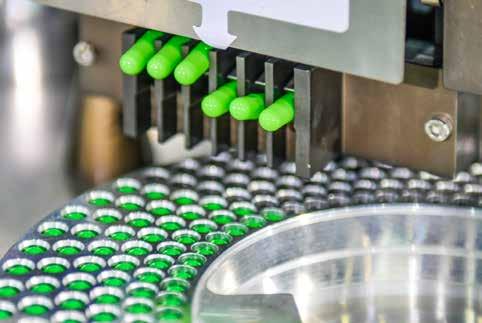

soon after updates to the specification are finalized and published. IPv6 now makes up almost half of all Internet traffic, and the growing proliferation of IoT devices, sensors, and interconnected machinery on the OT floor demands more address space, which IPv4 cannot provide. In addition to IPv6, presentations also covered:
• Tools available to enable time synchronization for 5G and how they relate to CIP Motion.
• CIP Security protections, including device identity management, secure communication protocols, and vulnerability mitigation, with a view to compliance with the EU Cybersecurity Resilience Act (CRA) and Machinery Safety Act
• An overview of the use of Artificial Intelligence (AI)/Machine Learning (ML) applications in the autonomous train market
• The potential addition of metadata to ODVA’s device description files to provide contextualized presentation of devices both off-line and on-line
• The potential for implementing Bluetooth for industrial use cases with CIP communications as the application layer
interface for devices and software clients
• CIP Energy building blocks for real-time energy monitoring, dynamic demandresponse capabilities, and energy optimization algorithms that are needed to reach carbon neutrality
• ODVA defined best practices for Concurrent Connections redundancy and a brief plan for the adoption and implementation of Concurrent Connections
• The protection of EDS files that are used to describe a CIP device
• The use cases that FCG – together with ODVA, PNO and OPC Foundation – wish to address
• The expansion of the EtherNet/IP In-cabinet ecosystem
• A user’s perspective on wired EtherNet/ IP network architectures
Technical papers and presentations from this and previous ODVA Industry Conference and Annual Meetings are available here: https://www.odva.org/news-events/ industry-conference/library-of-proceedings/.
News report by ODVA
Machine learning for all automation sectors
TwinCAT Machine Learning: AI is simply integrated into the control level
AI models as a function block in the PLC: AI as a component of the control code
real-time execution on the standard control IPC: in sync with motion, sequential logic, vision, and much more
acceleration of complex AI models: Beckhoff IPC with NVIDIA GPU and interface from the PLC automated training of AI models: AI model creation that doesn't require AI expertise
open interface for trained AI models (ONNX): trained AI with interoperability
AI model lifecycle management: model updates without compilation, stop, and restart


Hall 9, Booth F06
Time-Sensitive Networking system-level solutions
TSN backers continue to emphasize the inherent strengths of TSN networking technology. But now, new silicon solutions are set to enable step-by-step integration of TSN capabilities into a wide range of automation devices, potentially alleviating one of the greatest obstacles to greater adoption.

FOR THIS SPECIAL REPORT ON TSN IN FACTORY automation, IEB reached out to industry experts to get their perspective on the technologies that are impacting TSN in smart manufacturing operations.
A key advantage of Time-Sensitive Networking is how it leverages innovative networking technology, combining traffic scheduling, prioritization and shaping in high performance manufacturing systems while also enabling the coexistence of disparate traffic types and protocols on the network.
But now in addition to the technology benefits of TSN itself, new silicon (Ethernet chipsets) are offering communication interfaces with multi-protocol support for a variety of protocols could alleviate one of the greatest obstacles to more widespread adoption.
System-level TSN solutions
New silicon enabling step-by-step integration of TSN capabilities in all automation devices
Gunnar Lessmann, Master Specialist Profinet and TSN, PLCnext Technology, Phoenix Contact GmbH & Co. KG said that one important prerequisite for TSN in factory automation is the integration of required capabilities and standards in all automation devices and network switches without additional cost.
“More and more silicon vendors integrate TSN capable interfaces in new generations of their silicon, while these are the same or less costly, than the version before. This leads to a step-by-step integration of TSN capabilities in all automation devices,” Lessmann said. Lessmann said that one other important
activity is the integration of relevant TSN features like time-synchronization according to IEEE 802.1AS and high precise frame transmission in Linux mainline kernels and tools. Both aspects will lead to decreased device and development cost of TSN devices combined with more performance. This integration in end devices is a must, to utilize new solutions like virtual PLC. Without TSN capable interfaces in hardware machines, such solutions will not be possible.
Furthermore, ongoing standardization activities like PROFINET, OPC UA FX, or IEEE/ IEC 60802/61802 are gaining momentum and will find their way in the market.
“With that in mind, it is expected that all customers and applications which benefit from a converged network instead of separate networks will adopt the
“More and more silicon vendors integrate TSN capable interfaces in new generations of their silicon, while these are the same or less costly, than the version before. This leads to a step-by-step integration of TSN capabilities in all automation devices.” -- Gunnar Lessmann, Master Specialist Profinet and TSN, PLCnext Technology, Phoenix Contact.
technology,” Lessmann said. “One example is the communication in large windfarms, where time synchronization and large data transfer is required in one network. In applications like these, it is not reasonable to use separate networks.”
Figures 1 and 2 show the adoption of separated networks towards one converged TSN network.
Lessmann said that there are some challenges, which need to be solved to enable such a network. The communication standards like PROFINET or OPC UA (FX) together with the base IEEE/IEC 60802 shall cover the required functionality and have the needed maturity. Furthermore, interoperability and conformance tests must cover these standards as well. This guarantees the problem-free operation in all end customer cases.
Specific technology benefits
Lessmann said that in converged networks, as shown above, TSN is offering some technologic benefits. In particular:
• High precise time synchronization with accuracy better then 1µs even in larger networks
• Scalable bandwidth from 10Mbit/s to 10Gbit/s
• Transportation of real time-critical and best effort Ethernet traffic without mutual influence and predictable latency
• Bump less media redundancy for real-time data, if required by the application
• Seamless Integration of existing “Brownfield” devices without breaking the system usability
These benefits are not fulfilled with more “Fieldbus” -like specialized systems. In long-term the benefit of a unified converged network will be adapted by all applications starting with those, where the effort vs. benefit is positive.
TSN is applicable for all types of applications and customers. Examples of applications include:
• Manufacturer of a series of machines where the network in the machine itself is implemented with only one system replacing multiple specialized networks and devices.
• Integration and operation of multiple machines in production cells and plants with real-time critical controller to controller and controller to IT communication
• Integration of monitoring devices like IP-cameras in the same network, where the image recognition is running on a powerful platform.
• Machine learning applications based on synchronized cameras or vibration sensors.
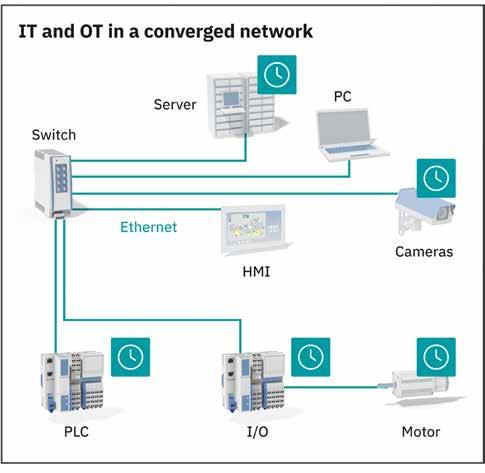
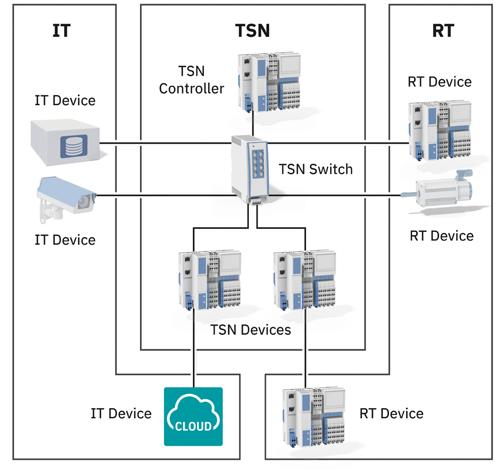
Figure 1: One converged TSN network integrating all automation devices and disciplines.
Figure 2: Example for a converged network with IT, Realtime Critical and TSN components.
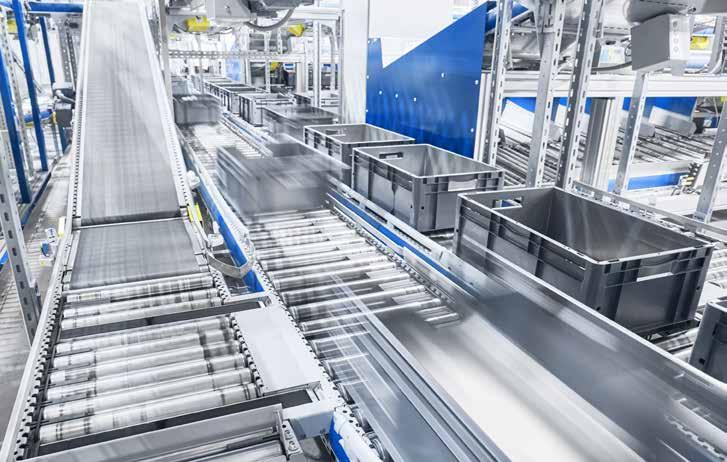
• Virtualized PLCs running on COTS (custom off the shelf) Hardware- and Software. This is an enabling use-case for new possibilities like combining PLC and machine learning on the same machine with the same network. Figure 2 shows one example.
Anticipated TSN impact
“With the capabilities of TSN standards and the integration in all automation components we expect more and more replacement of specialized and separated systems to be integrated,” Lessmann said. “In combination with new possibilities like virtual PLC, machine learning and AI, TSN is will be the enabling technology without alternatives. Due to seamless brownfield integration concepts this transition can be smooth according to the most benefits of the respective specific application. Even though this transition will take time. The next 1-3 years will tell.”
Ethernet with TSN
Gigabit speeds combined with traffic scheduling, prioritization and shaping
According to Thomas Burke, Strategic Global Advisor at CC Link Partner Association, Time
Sensitive Networking is continuing to evolve for use in factory automation applications.
“Ethernet with Time Sensitive Networking is leveraging the latest in technology including Gigabit Ethernet speeds combined with traffic scheduling, prioritization and shaping,” Burke told the Industrial Ethernet Book recently. “These features enable the
highest level of performance while also enabling the coexistence of disparate traffic types and protocols.”
Burke said that the support of these latest features requires an upgrade to new silicon (new Ethernet Chipsets). This creates a common challenge for device designers and there are several companies that offer communication

CC-Link IE TSN has been available since 2018, and dozens of device manufacturers are delivering compatible products.
“Ethernet with Time Sensitive Networking is leveraging the latest in technology including Gigabit Ethernet speeds combined with traffic scheduling, prioritization and shaping. These features enable the highest level of performance while also enabling the coexistence of disparate traffic types and protocols." -- Thomas Burke, Strategic Global Advisor at CC Link Partner Association.
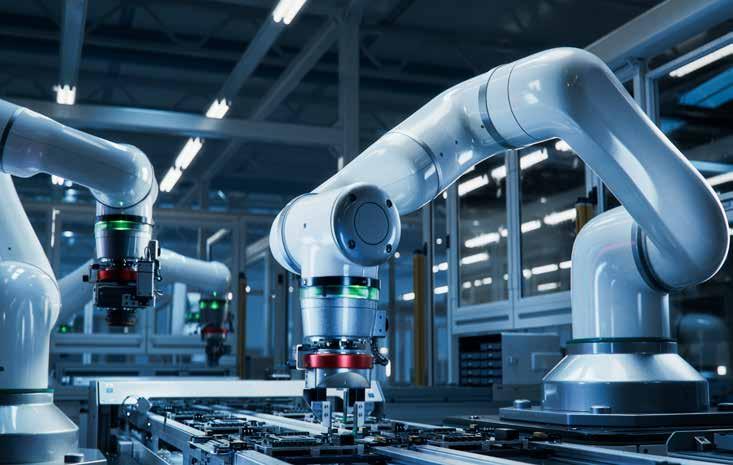
interfaces with multi-protocol support.
“In the case of Ethernet with TSN-based protocols, one leading protocol, CC-Link IE TSN has been available since 2018, and dozens of device manufacturers are delivering compatible products. Major protocol vendors including Hilscher, HMS, Renesas offer new chipsets with support for a variety of protocols. This alleviates the greatest obstacle to adoption,” Burke said.
Technology benefits
One of the key technology benefits of TSN is that it delivers the ability to schedule communications at the microsecond level.
This scheduling, combined with prioritization of messages and the ability to shape large traffic, and preempt messages, enable guaranteed performance for critical traffic (motion control for example), while coexisting with video, data acquisition or maintenance communications. The ability to combine various communications on a common and open network is not available through any other solution.
Applications and impact
Burke said that applications that benefit from advanced motion control, the coordination of many axes, or the coordination of drives along
a common machine for printing or lamination are common applications including printing machines and battery winding machines. While these machines require a great deal of coordination, other machines with many, even non-coordinated axis, can benefit from the control of many devices from a single, much more cost-effective controller.
Burke added that he expects TSN technology will continue to have on smart manufacturing in the next several years.
“While CC-Link IE TSN is currently the dominant solution for Ethernet with TSN communications, a number of other protocol solutions are soon to enter the market and will be supported by System on Chip (SoC) communication vendors,” Burke said. “There is no alternative to this technology trend. Ethernet with TSN is the next logical step for open, standards based industrial communications.”
Impact on automationfactory
Enhanced real-time communication and network convergence
“Time-Sensitive Networking (TSN) is evolving to enhance real-time communication and
network convergence in factory automation. It supports applications like robotics and advanced motion control with deterministic communication and low latency, autonomous operation using vision systems and AI with high bandwidth and data streaming, and connectivity for legacy components as well as the most up-to-date TSN enabled devices,” Georg Stöger, Senior Principal Technology Specialist at TTTech said.
Stöger said that adoption on a larger scale progresses slowly, because compatible devices and infrastructure are not widely available. For this reason, customers typically do not proactively switch to TSN technology to benefit from its known advantages until the existing legacy technologies do not meet new requirements such as higher bandwidth.
In addition, he added that interoperability between different vendors’ equipment might need to be improved. Despite TSN’s adherence to IEEE standards, different device capabilities exist beyond those defined as mandatory by the applicable TSN profile(s). Lastly, the evolving cybersecurity landscape necessitates robust security measures to protect converged IT-OT networks, adding another layer of complexity to any system upgrade, including the move towards TSN.
“Time-Sensitive Networking is evolving to enhance real-time communication and network convergence in factory automation. It supports applications like robotics and advanced motion control with deterministic communication and low latency, autonomous operation using vision systems and AI with high bandwidth and data streaming, and connectivity for legacy components," Georg Stöger, Senior Principal Technology Specialist at TTTech.

“Time-Sensitive Networking is evolving to enhance real-time communication and network convergence in factory automation. It supports applications like robotics and advanced motion control with deterministic communication and low latency, autonomous operation using vision systems and AI with high bandwidth and data streaming, and connectivity for legacy components," Georg Stöger, Senior Principal Technology Specialist at TTTech.
Despite these challenges, the long-term benefits of TSN make it a promising technology for smart manufacturing.
Factory automation applications
“While TSN is sometimes still considered mainly as fieldbus, TSN in fact offers key benefits for factory automation applications: It provides deterministic real-time communication over standard Ethernet, ensuring low latency and high reliability for multiple industrial traffic classes simultaneously,” Stöger said.
“This is critical for precise control and synchronization in automated processes. The key principles to achieve this are time synchronization and traffic scheduling, allowing for the convergence of IT and OT networks and applications on a single TSN network backbone infrastructure.”
Identifying specific competing solutions to compare TSN with is tricky here, because TSN's unique advantage lies in the combination of the aforementioned determinism and its adherence to IEEE standards, which ensures compatibility to legacy devices and at the same time makes solutions more future-proof. No other set of IEEE standards offers these capabilities for support of OT networking, and unlike proprietary protocols which may offer similar benefits on a factory network, TSN's standardized approach allows for broader adoption and compatibility across different vendors and devices.
Meeting high bandwidth requirements
"A notable trend is to consider using TSN not just for its determinism, but to address high bandwidth requirements, arising from innovative applications such as vision systems and data analytics," Stöger said. He added that, of course, OT applications that require deterministic network communication and applications which need a lot of network bandwidth are not mutually exclusive in complex systems such as a factory or large machine network. TSN’s standards-based independence from any specific restriction with respect to physical layer (optical, electrical…) and data rate constraints (10/100 Mbit/s, 1 Gbit/s, 5 Gbit/s…) is ideally suited to provide determinism for some traffic classes while supporting very high network bandwidth in the 10 Gbit/s range for other traffic classes.
Although 10 Gbit/s data rates are not currently mandated by any TSN profile, implementations are available and customer interest for TSN network data rates beyond the mandatory 1 Gbit/s exists.
Looking ahead
“The current key trends we observe include increasing autonomy in automation and a strong focus on cybersecurity,” Stöger said.
Autonomy does not only affect “wired” assets such as stationary robots and machines,
but also mobile assets (AGVs) which need to use wireless data communication in the automation system.
Wireless data communication that nevertheless needs to provide comparable capabilities to TSN goes beyond the scope of IEEE TSN and the industrial TSN profile and needs “wireless TSN”, where a combination of TSN networks and 5G networks is used to achieve the required network QoS, synchronization, robustness, and determinism.
“The cybersecurity aspect is very challenging because it must address the increasing multitude and dynamics of network data flows introduced by AI and on-demand network requirements such as ‘plug and produce’ but also provide the transparency and diagnostic capabilities needed to ensure that applicable regulatory frameworks can be met,” Stöger added.
“Consequently, we expect that in the coming years TSN will contribute to smart manufacturing networks mainly in the areas of reliability and robustness. But as stated earlier, we also see massive increases in bandwidth demands for some applications, driven for example by AI applications which need to process a large amount of near-realtime vision data for autonomous functions in smart manufacturing.”
Al Presher, Editor, Industrial Ethernet Book
Industrial Ethernet with TSN: transforming connectivity
Industrial Ethernet with TSN is redefining connectivity, offering deterministic performance, high bandwidth, and flexibility for a digitally connected world. From robotics and CNC machining to AGVs, packaging, and beyond, TSN empowers diverse markets to meet the demands of precision and smart operations.
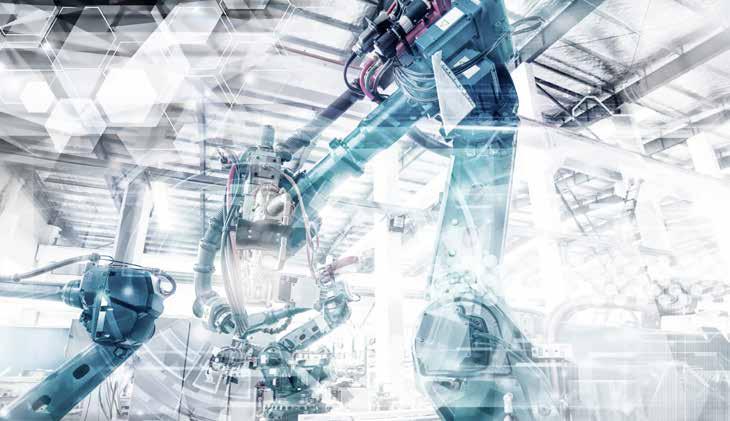
As industries embrace digital transformation and smart operations, TSN-empowered Ethernet is unlocking new possibilities across a wide range of markets. TSN enhances Ethernet with features like traffic prioritization, traffic shaping, and precise time synchronization to enable deterministic communication.
INDUSTRIAL ETHERNET HAS LONG BEEN A cornerstone of modern automation, but its evolution with Time-Sensitive Networking (TSN) technology marks a significant leap forward. Introduced in 2016, TSN enhances Ethernet with features like traffic prioritization, traffic shaping, and precise time synchronization, enabling deterministic communication critical for real-time applications.
These advancements allow diverse data types—ranging from high-priority motion control signals to video streams and sensor data—to coexist on a single network without compromising performance. As industries embrace digital transformation and smart operations, TSN-empowered Ethernet is unlocking new possibilities across a wide range of markets and applications.
How TSN enhances Industrial Ethernet Determinism—the ability to deliver data packets within a predictable time frame—is
essential for applications requiring precision, such as motion control, data acquisition, and real-time imaging. Standard Ethernet faces challenges that can disrupt this predictability, including:
• Network Traffic: Bursts of data from non-critical sources can introduce latency or jitter.
• Switching Delays: Protocols like TCP/ IP may cause variable delays due to retransmissions or packet reordering.
• Interference: Non-real-time traffic, such as file transfers or video streaming, competes with time-sensitive packets.
• Topology Issues: Complex or inefficient network designs increase latency.
TSN addresses these hurdles with innovative protocol enhancements. Traffic prioritization allows high-priority messages to preempt less urgent ones, while traffic shaping breaks large data packets into smaller, manageable chunks, interspersing critical messages seamlessly.
Time synchronization aligns the clocks of all connected devices to sub-microsecond accuracy, enabling scheduled communication rather than reliance on collision detection. Together, these features ensure reliable, high-bandwidth performance, making TSN-enhanced Ethernet a game-changer for industries requiring precision and scalability.
Enabling diverse applications
Since its standardization, TSN has been supported by advanced silicon chips, firmware, and protocols like CC-Link IE TSN, an open standard led by Mitsubishi Electric and managed by the CLPA (CC-Link Partner Association). Available since 2018, TSN-capable devices and switches— including those supporting daisy-chain configurations—offer flexibility and high-speed gigabit connectivity. This empowers applications that integrate multi-axis motion control, extensive data acquisition, and video imaging, delivering




millisecond-level precision and robust bandwidth across markets.
Key markets and applications benefiting from TSN
Industrial Printing: Digital presses and 3D printers demand tight coordination between printhead movements, substrate feeds, and real-time monitoring (e.g., ink levels, defect detection via video). TSN ensures synchronized motion and imaging, with bandwidth to stream high-resolution analysis, enhancing throughput and quality.
Robotics and Multi-Axis Control: Robotic systems, such as 6-axis robots and manipulators, rely on deterministic communication to align joint movements, sensor feedback (e.g., force/torque), and vision systems for object recognition. TSN maintains sync across subsystems, supporting complex tasks in manufacturing and logistics.
Automated Guided Vehicles (AGVs) and Warehousing: AGVs navigating warehouses use motion control (wheels, steering), LIDAR, and video for obstacle detection. TSN enables fleets of AGVs to run autonomously, leveraging islands of TSN on the AGV for ultimate performance, and to share real-time position data over a wireless, high-bandwidth network, optimizing coordination and efficiency.
CNC Machining: Precision metalworking requires synchronized multi-axis control (e.g., spindle, toolpath) alongside diagnostics (e.g., vibration sensors, tool wear imaging). TSN delivers tight timing and bandwidth for


high-frequency data, improving accuracy and uptime.
Semiconductor Manufacturing: Wafer fabrication involves intricate robotic handlers, defect sensors, and optical inspection systems. TSN’s sub-microsecond coordination and massive data capacity ensure flawless operation and quality control in this high-stakes industry.
Packaging and Food Processing: High-speed lines integrate conveyors, robotic arms, weight sensors, and label verification cameras. TSN guarantees precise timing for cutting and sealing while supporting data-heavy traceability requirements.
Medical Device Production: Assembling precision devices like pacemakers requires multi-axis control, sensor feedback, and imaging for quality checks. TSN ensures real-time monitoring and coordination in sterile, high-precision environments.
Energy Systems: Wind turbines adjust blade pitch using motion control and monitor conditions via sensors and video, while smart grids synchronize distributed data. TSN enables real-time adjustments and highbandwidth oversight.
Broader implications
TSN’s ability to blend deterministic performance with protocol coexistence—while leveraging Ethernet’s gigabit bandwidth and ubiquity— makes it a versatile backbone for smart industries. Markets pushing the envelope, such as those combining motion, data, and imaging,


benefit most, gaining competitive advantages in efficiency, reliability, and scalability. The availability of TSN-capable components simplifies network design, ensuring seamless integration across applications.
Spotlight application
A notable example is Keller, a Polish OEM, which has harnessed CC-Link IE TSN in a bottle printing machine. By leveraging TSN’s deterministic motion control over multiple servos, the system achieves exceptional productivity, accuracy, and precision— demonstrating the technology’s transformative potential. Watch video on YouTube: https:// www.youtube.com/watch?v=-4CCOQKKKKc
Conclusion
Industrial Ethernet with TSN is redefining connectivity, offering deterministic performance, high bandwidth, and flexibility for a digitally connected world. From robotics and CNC machining to AGVs, packaging, and beyond, TSN empowers diverse markets to meet the demands of precision and smart operations. As adoption grows, this enhanced Ethernet standard promises to drive innovation and efficiency across industries, proving its value as a foundational technology for the future.
Roy Kok, Senior Partner and Alliances Manager, CC Link Partner Association (CLPA).
Visit Website
Robotics and multi-axis control rely on deterministic communication, sensor feedback (e.g., force/torque), and vision systems for object recognition. TSN maintains sync across subsystems, supporting complex tasks in manufacturing and logistics.
TSN interoperability and certification pushes ahead
Why TSN interoperability and certification is a prime enabler for digital transformation. TSN capabilities time-critical data is delivered seamlessly to the different devices even with other traffic types present.
TIME SENSITIVE NETWORKS
“In the industrial sector, Avnu and other industry organization have made significant progress in creating an unified test specification for the IEC/IEEE 60802 TSN profile as part of the TSN Industrial Automation Conformance Collaboration (TIACC). " -- Dave Cavalcanti, President, Avnu Alliance.
VARIOUS INDUSTRIES INCLUDING PROAV, Industrial , Automotive, and Aerospace –are currently undergoing a transformation from traditional single purpose computing and networks to software defined systems and converged networks based on standard connectivity.
Legacy systems that are built on dedicated hardware and proprietary communication protocols are increasingly being replaced by virtualized systems that operate as software workloads and run on ‘general purpose’ computing and network infrastructure.
Increasingly, software-defined and AI workloads require strict real-time performance. Live performances are dependent on precisely synchronized audio and seamless visual experiences, while virtual programmable logic controllers (PLCs) on factory floors are becoming commonplace.
For networking and compute solution providers, this transformation may be causing significant – and often disruptive – change,
but they are both necessary and inevitable. It’s no longer a question of if it needs to happen, but when.
The need for innovative networking approaches
It’s for this reason that businesses are turning their attentions towards converged networking, especially for the integration of Information and Operational Technologies (IT/OT). The optimal choice for supporting software defined and AI workloads, converged networks are integral in supporting real-time applications, combining wired and wireless connectivity – alongside enhancements for deterministic performance – these allow for easy integration and co-existence of device types and applications.
Underpinning these networks are Time Sensitive Network (TSN) capabilities. These ensure time-critical data is delivered seamlessly to the different devices even with other traffic types present. This allows data
to reach its intended destination without the fear of disruption or delays. Interoperable TSN components are critical for augmenting existing IT networks in order to enable convergence of mixed criticality applications.
Innovative concepts vital to modern networks, including time synchronization, traffic shaping and resource management can be found in TSN toolbox and specified in IEEE 802.1 TSN standards. The use of TSN can empower businesses to move beyond single function and proprietary networks solutions, which are becoming increasingly archaic in the age of Internet of Things (IoT) and AI.
Time synchronization (based on the 802.1AS protocol) and traffic scheduling enhancements (based on 802.1Qbv) help ensure greater determinism for time-critical data flows. These capabilities are driven by open TSN standards with broad industry support, which continue evolving and improving real-time performance on standard Ethernet and wireless networks.
Driving adoption through industry collaboration and interoperability
In recent years, Avnu Alliance and its members have made significant progress in driving deployment of AVB and TSN technologies in the Professional AV market through industry standards, collaboration and certification of products.
Interoperability is a fundamental step for large scale adoption and deployment. Within the ProAV sector, this has been demonstrated through Milan® – Avnu Alliance’s application layer standard for deterministic, reliable, future-proofed delivery of media.
The solution has been utilized across a number of different venues and events, including the Hollywood Bowl, Coachella, and the Millenium Centre. A wide-ranging list of use cases can be found on our website.
In the industrial sector, Avnu and other industry organization have made significant progress in creating an unified test specification for the IEC/IEEE 60802 TSN profile as part of the TSN Industrial Automation Conformance Collaboration (TIACC).
Automation within factories and over industrial facilities has continued to drive advances in IEEE TSN standards, in order to meet strict time and real-time performance over Ethernet and wireless networks. Through a collaborative effort from across the industry, we have achieved a major milestone; the IEEE 60802 TSN profile for industrial automation is now reaching final approval by both the IEEE and IEC standard bodies.
This profile defines a subset of the TSN core capabilities and additional performance requirements that are crucial in meeting the needs of industrial automation applications.
The spirit of collaboration was also demonstrated by the TIACC announcement, and the progress made towards a unified 60802 TSN profile test specification. Major industrial and automation-focused standard organizations including the Avnu Alliance, OPC Foundation, Pofinet International, ODVA and CC-Link established TIACC because it’s critical TSN implementations can interoperate and support all existing industrial application protocols – and all over the same converged network.
The power of certification
The interoperability of TSN components and products is pivotal if converged networks are to expand into existing and new markets. This is one of the reasons why Avnu launched the Component Certification Program, the first-of-its-kind to certify compliance with the IEEE 802.1 TSN standards used

In the industrial sector, Avnu and other industry organization have made significant progress in creating an unified test specification for the IEC/IEEE 60802 TSN profile as part of the TSN Industrial Automation Conformance Collaboration (TIACC).
across markets, such as ProAV, industrial, aerospace, automotive and others. Initially focusing on 802.1AS and 801.Qbv, further TSN capabilities including interspersed express traffic (IET) and the forwarding and queuing of time-sensitive streams (FQTSS) are expected to be launched shortly.
Avnu’s TSN certification has also been streamlined for network devices such as Ethernet switches in 2024. This includes network elements defined by IEEE in its 802.1BA Audio Video Bridging (AVB)/TSN profile, as well as the upcoming IEC/IEEE 6082 profile for industrial automation. The precise timing within devices and determinism for time-critical data across the network delivered by the Avnu certified products will support the coexistence of different traffic types on the same network. More certification programs are on the horizon, and we look forward to announcing further details in due course.
A forum for collaboration and converged network adoption
These major breakthroughs highlight the strong collaboration and commitment by Avnu Alliance’s members to drive standards and interoperability. The technical specifications, partnerships and certification programs established by Avnu – driven by member contributions to various Working Groups and Plugfests events – are enabling adoption of innovative TSN technologies for the benefit of several industries.
For the Industrial and Automotive sectors, we are helping businesses to overcome the challenges of disruptive innovation enabled by TSN capabilities. As we continue to roll out new developments and certification programs in 2025, we hope this will provide the impetus for more businesses to embrace the benefits of TSN, whatever their industry.
Dave Cavalcanti, President, Avnu Alliance
Maximizing TSN: unlocking benefits & overcoming challenges
TSN bridges the gap between today's fragmented networks and the unified networks of tomorrow by enhancing standard Ethernet with standardized, deterministic, high-performance networking capabilities that enable the seamless integration of various industrial Ethernet protocols into one unified network.

IMAGINE A FACTORY FLOOR WHERE MACHINES communicate with each other with such precision that even a millisecond of delay can lead to costly downtime. How can we prevent a scenario like this and ensure the timely and accurate transmission of data? What if an advanced Ethernet technology, prioritizing every millisecond, galvanized a complete shift in industrial automation?
This is the promise of time-sensitive networking (TSN), a cutting-edge technology set to revolutionize industrial automation. The numbers don't lie: analysts project that the global TSN market will grow by a staggering 58.3% annually, reaching a value of USD 1.7 billion by 2028, according to a MarketsandMarkets report.
In this article, we will explore what is driving the rise of TSN, how it’s reshaping industrial efficiency, the challenges when
deploying this technology, and ways to tackle these challenges.
Key benefits of adopting TSN
TSN’s transformative power is evident, for example, in a major home appliance manufacturer, resulting in significant improvements across several key areas:
Deterministic Communication: The low-latency, deterministic traffic scheduling of TSN allowed for precise control and synchronization of production line devices. This enhanced real-time control and overall system responsiveness, crucial for maintaining high performance in data-intensive environments.
Interoperability: TSN enabled the seamless integration of diverse production equipment from different vendors, simplifying network management and optimization. This streamlined network
management and optimization ensured consistent compatibility and performance throughout the production line.
Convergence of IT and OT: By unifying IT and OT systems on a single network, TSN streamlined operations, reduced overhead, and enabled faster decision making.
Simplified Network Complexity: TSN consolidated network communications into a single, simplified architecture based on standard Ethernet, reducing complexity and costs while allowing for easy scalability.
Enhanced Productivity: TSN’s ability to prioritize control data and ensure timely transmission enhanced productivity for the manufacturer, resulting in reduced downtime, faster response times, and increased equipment effectiveness.
The cumulative effect of these enhancements was improved operational efficiency, higher productivity, and
Current trends in manufacturing automation and data exchange, essential components of the Industrial Internet of Things (IIoT) and the larger framework of Industry 4.0, rely heavily on digitization. TSN is one of the key technologies offering solutions to help drive this digital transformation.
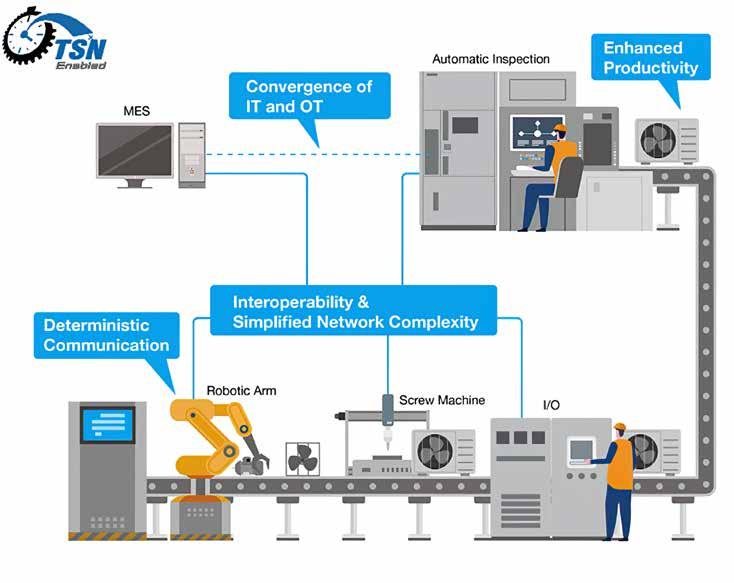
substantial progress towards the manufacturer’s goals for efficiency and precision.
Possible hurdles of adopting TSN technology
TSN offers convincing benefits that make it appealing for businesses to integrate their systems and assets into a unified TSN-powered industrial network. While there are benefits to combining mission-critical and non-critical networks, integrating a new technology such as TSN will introduce additional challenges. Organizations considering implementing the new technology may have concerns regarding these requirements. The following section will focus on these specific requirements and offer strategies for successful implementation. The key challenges include: Growing Data Volumes: As more devices and applications connect to networks, the amount of data traffic surges, requiring high-bandwidth capabilities to effectively
handle this increased demand. While Gigabit and 10G connections are crucial for speed, they also come with increased
costs and complexity in network resource management. The effective handling of bandwidth becomes even more critical as

TSN provides basic productivity and communication tools for enhancing the convergence of IT and OT systems.
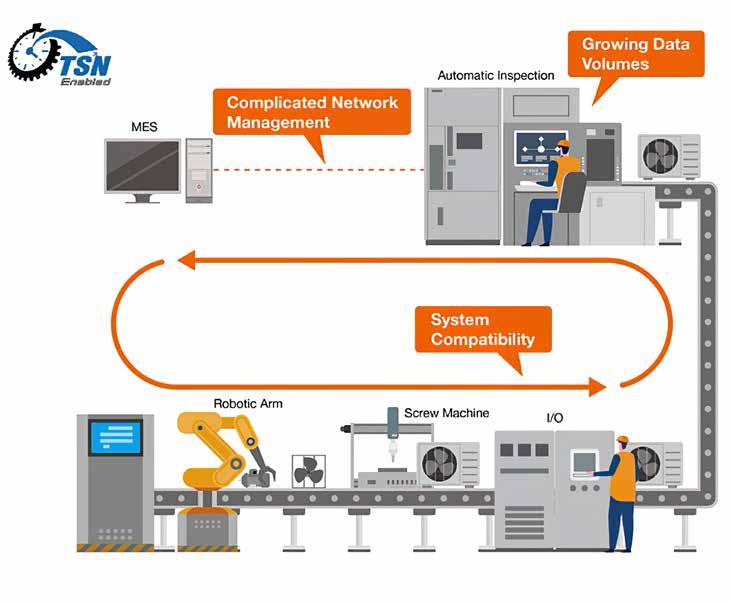
advanced applications like AI and machine learning continue to put a strain on these systems.
Network Management Complexity: With the growth of connected devices in a converged TSN network, managing the network will become more complex. Sophisticated management and configuration tools, such as Central Network Controllers (CNCs), are essential for simplifying these processes. However, enterprises may feel overwhelmed when implementing these solutions, given the need for technology investment, training, and ongoing maintenance.
System Compatibility: Using products that adhere to relevant testing specifications or are integrated into established testbeds makes achieving a smooth TSN implementation easier. These standards ensure compatibility and reliability, which are critical for easing integration challenges and speeding up efficiency gains. However, finding, validating, and integrating these standardized products can be timeconsuming and resource-intensive, often
requiring specialized expertise to navigate the various standards and certifications.
The path to successful TSN integration
It’s important to recognize that TSN integration involves complexities. As mentioned before, the benefits—including improved real-time control, seamless interoperability, and converged network architectures—are substantial, but there are also challenges to address.
To ensure a successful deployment, organizations must consider multiple critical aspects:
Full Gigabit Performance: As data demands increase in industrial environments, efficient handling of higher data volumes necessitates high-bandwidth capabilities. Therefore, it is crucial to choose TSN solutions that support full Gigabit speeds on each port to ensure robust network performance. Highbandwidth and low-latency communication are vital for maintaining real-time data exchange, enabling precise control and
responsiveness essential for complex industrial processes.
Easy Configuration: Look for intuitive management tools, such as web-based graphical user interfaces (GUIs), that simplify device setup and management. This is particularly important for largescale deployments where complexities can escalate.
Compact and flexible design: Choose equipment with a compact and adaptable design that can easily fit into small areas. Space-saving designs allow for seamless integration of advanced networking capabilities into your existing infrastructure.
Compatibility: Make sure the products align with the required testing specifications or are included in existing testbeds. Adhering to these standards helps guarantee seamless compatibility and reliable performance, essential for successful TSN integration.
Technology article by Moxa.
Visit Website
TSN solutions simplify network management, providing
system compatibility and tools for analyzing vast amounts of manufacturing data.
Power of TSN and RTOS integration for aerospace
The integration of TSN and RTOS is not just a technological advancement; it is a strategic enabler for the next generation of networked systems. By providing a unified, deterministic and high-bandwidth communication solution, TSN and RTOS together pave the way for groundbreaking innovations in avionics, space and defense.

INTEGRATION OF TIME-SENSITIVE NETWORKING (TSN) with Real-Time Operating Systems (RTOS) marks a transformative milestone for the Aerospace industry.
This article examines TSN's ability to deliver deterministic, reliable, and highbandwidth communication, addressing aerospace's unique demands through the IEEE P802.1DP profile. By unifying protocols and optimizing architectures, TSN enhances performance, reduces complexity, and ensures Safety-critical communication. Its applications in Avionics, Space, and Defence systems streamline networks, cut costs, and support mixed-criticality traffic.
Together, TSN and RTOS enable future-ready, efficient, and resilient systems, redefining connectivity and laying the groundwork for innovation in Aerospace and beyond.
TSN: strategic enabler for avionics and space industries
Time Sensitive Networking (TSN) is not merely an enhancement to Ethernet; it is a transformative approach that redefines the capabilities of networked systems in critical
sectors. The Avionics and Space industries, where precision and reliability are not luxuries but necessities, find in TSN a technology that aligns with their visionary pursuits.
The advent of TSN marks a significant milestone in the evolution of network technologies. Its introduction into the Avionics and Space industries heralds a new era of connectivity, where the potential for innovation is matched by the performance of the network.
Unified technology: the convergence of capabilities
TSN stands out as a unified solution that encapsulates the core requirements of modern avionics systems. It converges reliability, determinism, and high bandwidth into a singular, robust framework, paving the way for a new generation of networked systems.
The Ethernet backbone of TSN offers unparalleled market benefits. It taps into an established ecosystem, bringing with it the advantages of a wide array of COTS products, a large market presence, and a diverse pool of vendors. This positions TSN as a technology not just of the present but also of the future.
Reliability: the foundation of trustworthy communication
At the heart of TSN lies the promise of reliability, a promise that is critical in unforgiving critical environments.
The IEEE 802.1CB standard introduces mechanisms like FRER (Frame Replication and Elimination for Reliability), which ensure continuous communication even in the face of potential network disruptions. Complementing this, IEEE 802.1Qci provides stringent filtering and policing, fortifying the network against errors and enhancing its resilience.
Synchronization: Orchestrating a Unified Network Tempo Synchronization is the conductor of the network orchestra, ensuring each device plays in harmony with the others.
With IEEE 802.1AS at its core, TSN achieves a level of synchronization that is imperative for the coordinated tasks of the missions. This standard is the linchpin for operations where every nanosecond counts.
Latency: the pursuit of immediate responsiveness
In the realm of real-time operations, latency
Figure 1. List of TSN protocols categorized by functionality. Source: IEEE (www.ieee802.org/tsn)
is the difference between success and failure.
TSN addresses low and bounded latency through a suite of protocols, each designed to ensure that time-critical data is accorded the highest priority and delivered within the tightest timeframes, thus maintaining the rhythm of real-time responsiveness. IEEE 802.1Qbv (Time Aware Shaper) and 802.1Qav (Credit Based Shaper), and 802.1Qbu for Frame Preemption ensures the QoS and constrains for the critical flows.
Resource management: maximizing network efficiency
Effective resource management is akin to a well-orchestrated ballet, where each movement is both precise and purposeful.
The IEEE 802.1Qcc standard is the choreographer of network resources, directing traffic with an eye for efficiency and an understanding of the network’s dynamic needs.
IEEE P802.1DP aerospace profile
The aerospace profile of TSN, IEEE P802.1DP, is a testament to the adaptability of TSN to the specialized needs of the aerospace sector.
Recognizing the diverse nature of aerospace applications, the IEEE P802.1DP profile accommodates both synchronous and asynchronous communication needs. This dual modality ensures that TSN can support a wide range of applications and legacy implementations, from those requiring strict timing to those that can tolerate some degree of latency.
The profile outlines the supported TSN protocols, each selected for its ability to transport time-sensitive data streams with the precision and reliability that Aerospace applications demand. It is a profile that not only meets the current needs of the industry but also anticipates its future directions.
This expanded introduction provides a holistic view of TSN’s role in avionics and space industries, setting the stage for a detailed exploration of its integration with RTOS and the synergies that arise from this powerful combination.
The importance of Real-Time Operating Systems with TSN
Operating Systems (OS) are pivotal in managing the allocation of processing elements, such as processors or cores, to various software units, known as threads or processes. This allocation occurs both physically and temporally. In
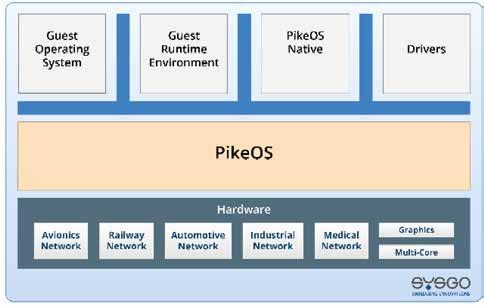
Symmetrical Multiprocessor Systems (SMP), an OS determines which processor a specific thread or process runs on and when it gets to use the processing element, balancing its usage with other processes.
General Purpose Operating Systems
General-purpose operating systems often prioritize performance, immediately allocating available processing elements to pending software units. While this approach can be efficient, it may lead to issues such as cache contention. Modern processors contain firstlevel caches that store memory blocks for executing applications. Arbitrary allocation can degrade cache performance, causing variability in application execution times. Affinity policies can mitigate this effect.
Another example is operating systems that prioritize responsiveness, attending to interruptions promptly. While this enhances user experience, it can disrupt executing applications, preventing consistent execution times.
Real-Time Operating Systems
In contrast, Real-Time Operating Systems (RTOS) emphasize determinism, allowing system architecture to make predefined decisions rather than the OS itself. Features like reduced context switching and increased responsiveness (e.g., PREEMPT_RT in Linux) are beneficial but insufficient alone for deterministic execution in critical safety systems.
RTOS, such as PikeOS, enable physical partitioning of the system and resource allocation to specific software units. These units are restricted to their allocated resources, preventing interference with other partitions. Temporal partitioning is also crucial, ensuring software units do not exceed their allocated execution time. This is particularly challenging in multicore systems, where shared resources like internal buses can cause interference. RTOS can help minimize such interferences, essential for certifying high Safety-critical systems on multicore architectures.
This concept, known as Robust Resource and Time Partitioning, is outlined in the avionics standard ARINC 653. The system's timeline is defined, and software units are allocated accordingly, ensuring controlled resource usage.
RTOS with TSN
System time is typically maintained by an external crystal, driving various system clocks. In RTOS, this clock source ensures time coherence between software units. However, synchronization with external systems can be challenging. Precision Time Protocol (PTP, IEEE 1588) addresses this by defining a masterslave architecture for clock distribution, using timestamped messages to synchronize clocks across the network. TSN adopts a subset of PTP (IEEE 802.1AS) for sub-microsecond precision and supports wireless communications.
With time synchronization established,

Figure 2. PikeOS RTOS architecture
Table 1. TSN Protocols required as defined on IEEE P802.1DP for Aerospace TSN Profile
TSN can implement additional functionalities like scheduling, traffic shaping, and stream reservation protocols. TSN ensures synchronized clock sources, enabling harmonious and deterministic behavior across the entire technical ecosystem. This synchronization is often essential for the proper functioning of broader critical Safetyrelated systems.
Applicability of TSN in aerospace
The following case studies illustrate the diverse applications of TSN technology across the aerospace industry, highlighting its role in enhancing the performance, reliability, and efficiency of embedded real-time systems.
Case Study 1: TSN for Spacecraft Avionics
The space industry traditionally relies on various communication protocols such as MIL-STD-1553, SpaceWire, AFDX, and TTEthernet to meet mission requirements. These protocols cater to different network needs in terms of determinism, reliability, and high bandwidth, resulting in complex multi-protocol networks within spacecraft. TSN, with its deterministic and high-bandwidth capabilities, offers a unified Ethernet-based solution that can replace these multi-protocol networks, simplifying the architecture, reducing costs, and enhancing performance.
TSN's features also make it highly useful in Next Generation Launcher Communication Systems. Leading Space agencies, such as ESA and NASA, have recognized their importance and have shown significant interest in R&D projects aimed at developing such technologies and innovations.
OSRA-NET (Open System Architecture for Real-time Applications) is a framework that defines traffic classes to prioritize different types of data in real-time systems. In satellite and launcher communication, OSRA-NET traffic classes can be mapped onto TSN Quality of Service (QoS) classes to ensure efficient data transmission. For example, critical telemetry and control data can be mapped to highpriority TSN classes, ensuring minimal latency and jitter. Medium-priority classes can handle mission data that requires timely delivery but can tolerate some delays, while low-priority classes can be used for non-critical data such as housekeeping information.
A practical example of TSN in the space industry is the use of GNSS-based synchronization. The Global Navigation Satellite System provides accurate timing information, which can be utilized for synchronization in TSN networks through the IEEE 802.1AS standard. GNSS receivers on spacecraft and launchers provide precise timestamps, which are distributed across the TSN network. These timestamps synchronize all network devices, ensuring that data is transmitted and received at the correct times. This synchronization is
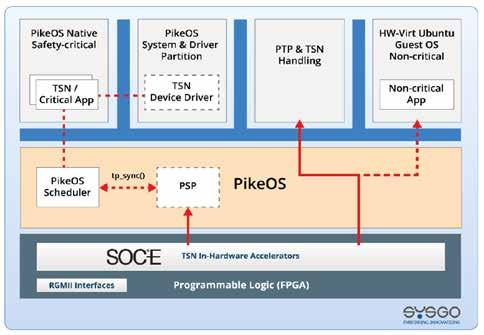
vital for maintaining the determinism and reliability of data in Space applications, enabling seamless and efficient communication.
Once the network is synchronized, an Attitude and Orbit Control System (AOCS) control loop can be integrated within TSN’s 802.1Qbv (Time-Aware Shaper) windows. By scheduling AOCS control loop data within Qbv windows, the system ensures that critical control commands are transmitted with minimal delay, improving the performance of AOCS actuators. This integration enhances the stability and control of both satellites and launchers, demonstrating the benefits of TSN in mission-critical applications.
In addition to improving performance and reliability, TSN contributes to significant weight reduction in launchers by simplifying the network architecture and reducing the need for extensive wiring. This weight reduction translates into cost savings, as the cost of putting an additional kilogram of payload into orbit remains significant despite recent reductions with reusable stage launchers.
In summary, TSN offers significant advantages for the space industry by providing a unified, deterministic, and high-bandwidth communication solution. TSN can enhance the performance and reliability of both satellite and launcher avionics systems, paving the way for more advanced and efficient space missions.
Case Study 2: TSN for Aircraft Avionics
In avionics control units, managing mixedcriticality traffic while ensuring deterministic and reliable communication is a critical issue. Time-Sensitive Networking (TSN) is being adopted as an upgrade over traditional ARINC 664 communication protocols, particularly in next-generation aircraft and helicopters.
Avionics systems must handle various types of data traffic with different levels of priority, ranging from non-critical data (like in-flight entertainment) to safety-critical functions (such as flight control and sensor data). TSN is highly suited for this task due to its ability to ensure deterministic communication, meaning that each packet of data reaches its destination at a guaranteed time, regardless of network load. This is essential for maintaining the precision and safety of flight control systems. Certain control systems rely on time-sensitive algorithms, such as autopilot and collision avoidance. TSN enhances these systems by scheduling time-defined slots for critical data, ensuring that high-priority communications are always delivered on time. This mechanism is particularly important for managing communication between subsystems like sensors, actuators, and flight control units, where even minor delays can affect performance.
As avionics become more sophisticated, the number of connected devices and the amount of data they generate increases. TSN helps manage this growing complexity by efficiently handling higher traffic and subscriber counts. This reduces the need for intricate and heavy wiring harnesses, which have been a characteristic of traditional ARINC-664 P7 systems. By lowering the wiring complexity, TSN contributes to weight reduction in aircraft, improving fuel efficiency and reducing network device costs.
In summary, TSN offers a robust solution for managing mixed-critical traffic in aircraft avionics systems. By ensuring deterministic and reliable communication, TSN enhances the precision and safety of flight control systems. Its ability to handle increasing data traffic and reduce wiring complexity translates into significant weight and cost savings, making it
Figure 3. SOC-E’s TSN integration with PikeOS scheduler.
an essential technology for next-generation aircraft and helicopters. TSN's integration into avionics systems not only improves performance but also paves the way for more advanced and efficient aviation technologies.
Case Study 3: TSN in Defence Critical Systems
Ensuring real-time, reliable communication for mission-critical systems in resource-constrained, dynamic defence environments is a significant challenge. The NATO Generic Vehicle Architecture (NGVA) platform requires robust, low-latency communication systems to manage both high-priority video traffic and critical vehicle functions. Time-Sensitive Networking (TSN) plays a crucial role by providing guaranteed Quality of Service (QoS), low-latency, and deterministic traffic management, which are essential for defence operations.
For land Defence scenarios, real-time video streaming is crucial for surveillance, target identification, and situational awareness. TSN ensures uninterrupted, high-quality video by reserving bandwidth for latency-controlled video streams, even in resource-constrained and high-demand environments.
Additionally, TSN supports seamless integration of various subsystems within military vehicles, such as navigation, communication, and weapon systems. By providing a unified network infrastructure, TSN reduces the complexity and weight of wiring harnesses, which is particularly beneficial in armored vehicles where space and weight are at a premium. This integration not only improves the overall efficiency and reliability of the vehicle's systems but also simplifies maintenance and upgrades.
TSN's scalability is another significant advantage for defence applications. As military technology evolves, TSN networks can easily accommodate new devices and functionalities without requiring extensive infrastructure changes. This flexibility makes TSN an ideal solution for future-proofing communication systems, ensuring they can adapt to emerging threats and technological advancements.
In summary, TSN offers substantial benefits for the Defence industry by providing a robust, low-latency, and deterministic communication solution. Its ability to handle mixed-criticality traffic, ensure real-time data transmission, and support scalable network architectures makes it an invaluable asset for modern defence operations. TSN's integration enhances operational efficiency, reliability, and adaptability, making it a critical component in the advancement of defence technologies.
Uniting SOC-E’s TSN and PikeOS
In the realm of Time-Sensitive Networking (TSN), SOC-E stands as a global leader, offering a comprehensive portfolio of solutions that range from high-performance TSN switches and endpoints to industrial-grade plug-
and-play devices. SOC-E’s expertise in TSN is complemented by SYSGO’s robust PikeOS, a real-time operating system (RTOS) known for its determinism, safety, and security. This section delves into the partnership between SOC-E and SYSGO, exploring how their combined expertise in TSN and RTOS creates a powerful synergy that benefits customers across various sectors.
A strategic alliance
The collaboration between SOC-E and SYSGO represents a strategic alliance that leverages the strengths of both companies. SOC-E’s TSN solutions ensure high-bandwidth, deterministic data transfer, which is essential for the Avionics, Automotive, and Industrial Automation sectors. When combined with PikeOS, these capabilities are enhanced, resulting in:
Deterministic Performance: PikeOS’s capabilities guarantee timely delivery of critical data, augmenting the deterministic nature of SOC-E’s TSN.
Cost Efficiency: The consolidation of multiple functions onto a single platform using PikeOS’s hypervisor technology reduces hardware requirements and costs.
Certification Confidence: PikeOS’s certification kits and modular architecture streamline the certification process, providing assurance in the system’s safety and security.
Long-Term Support: SOC-E’s and SYSGO’s commitment to product life cycle support ensures that customers receive consistent and reliable software updates and support.
Next-generation systems
The synergy between SOC-E’s TSN solutions and SYSGO’s PikeOS is more than the sum of its parts. It is a perfect match that accelerates the development and deployment of nextgeneration systems. This partnership not only enhances the performance and reliability of TSN systems but also opens new possibilities for innovation in connected industries.
Together, SOC-E and SYSGO are driving the future of connectivity, delivering solutions that are at the forefront of technology and tailored to meet the evolving needs of the avionics and space industries.
Conclusion and outlook
The integration of Time-Sensitive Networking (TSN) with Real-Time Operating Systems (RTOS) represents a transformative leap in the Aerospace industry. This whitepaper has explored the multifaceted advantages and applications of TSN, highlighting its critical role in ensuring deterministic, reliable, and high-bandwidth communication across various high-stakes environments. The TSN Aerospace Profile IEEE P802.1DP, specifically tailored for the unique demands of aerospace applications, ensures that both synchronous and asynchronous communication needs are met with precision and reliability.
TSN is not just an enhancement to existing network protocols; it is a revolutionary approach that redefines the capabilities of networked systems. In the Avionics and Space industries, where precision and reliability are paramount, TSN offers a unified solution that integrates reliability, determinism, and high bandwidth into a robust framework. This technology is pivotal in replacing complex multi-protocol networks, simplifying architectures, reducing costs, and enhancing overall performance. The IEEE P802.1DP profile plays a crucial role in this transformation, providing a standardized approach to meet the stringent requirements of aerospace communications.
The combination of SOC-E’s TSN solutions with the robust PikeOS RTOS ensures unparalleled performance and reliability. This integration guarantees that critical data is delivered on time, reduces hardware requirements through hypervisor technology, and streamlines the certification process, providing a comprehensive solution for modern networked systems.
The practical applications of TSN in aerospace and defence scenarios underscore its versatility and effectiveness. In spacecraft avionics systems, TSN simplifies network architecture, improves the performance of critical control systems and reduces the overall OBDH subsystem weight, and therefore, cost. In aircraft avionics, TSN manages mixed-criticality traffic, ensuring the precision and safety of flight control systems while reducing wiring complexity and improving fuel efficiency. In defence critical systems, TSN provides robust, low-latency communication essential for mission-critical operations, supporting seamless integration of subsystems and future-proofing defence communication networks.
As we look to the future, the potential of TSN combined with RTOS is boundless. This synergy is set to drive significant advancements in connectivity, enabling more sophisticated, efficient, and reliable systems across various sectors. The ongoing commitment to innovation and long-term support ensures that solutions will continue to meet the needs of the industry.
In conclusion, the integration of TSN and RTOS is not just a technological advancement; it is a strategic enabler for the next generation of networked systems. By providing a unified, deterministic, and high-bandwidth communication solution, TSN and RTOS together pave the way for groundbreaking innovations in Avionics, Space, and Defence. This article has laid the foundation for understanding the profound impact of these technologies, setting the stage for a future where connectivity and reliability are seamlessly intertwined.
Del Pino García, Javier, SOC-E; Ruiz Dorantes, Oliver and Walkembach, Franz, SYSGO.
Next generation automation machine control networks
Smart manufacturing is continuing to deploy diverse technologies to improve the performance of automation. This special report on next generation machine control looks at how AI, PLC virtualization, new controllers and software tools will provide solutions for real-time control, data connectivity and secure operations.

THE NEXT GENERATION OF MACHINE CONTROL will leverage of wide range of technology solutions to advance the overall performance, connectivity and security of smart manufacturing operations.
For this special report, the Industrial Ethernet Book reached out companies involved in developing machine control technology solutions. Here is what these industry experts had to say about the megatrends shaping Industrial Ethernet industrial networking.
From AI and PLC virtualization, to a push for on-machine data and control, to real-time data access, simplified connectivity and stronger security, along with Ethernet providing better solutions down to the device level, experts share their diverse insights into the technologies that will make a difference in next generation machine control.
Digital transformation
Key technologies include PLC virtualization and impact of AI
According to Vivek Bhargava, Product Marketing Manager at Cisco, the landscape of machine control networks in factory automation is undergoing a significant transformation driven by several key technology megatrends. Machine control networks operate in environments where precision, timing, and reliability are critical. Machine control often involves precise movements and positioning. Even small errors can accumulate, leading to significant deviations from the desired outcome.
“PLC virtualization is one of the new technology trends that are shaping machine control networks,” Bhargava told the Industrial
Ethernet Book recently. “When virtualized, the PLC is no longer connected to the machine in an L2 network, rather as the PLC is now software running in a collocated datacenter, it needs an L3 network which if not designed properly can introduce unacceptable delays.”
Bhargava said that another trend affecting these networks is the appeal of AI-driven analytics and data driven decision-making. To realize this potential, the network needs to collect and transport large amounts of data in near real time to software applications in datacenters and the cloud. A highperformance ultra-low-latency highly secure resilient industrial network with seamless data exchange with the enterprise network is a requirement.
“Real-time robotics and mobility control is another trend that imposes new requirements
"PLC virtualization is one of the new technology trends that are shaping machine control networks. When virtualized, the PLC is no longer connected to the machine in an L2 network, rather as the PLC is now software running in a collocated datacenter, it needs an L3 network which if not designed properly can introduce unacceptable delays." -- Vivek Bhargava, Product Marketing Manager, Cisco.
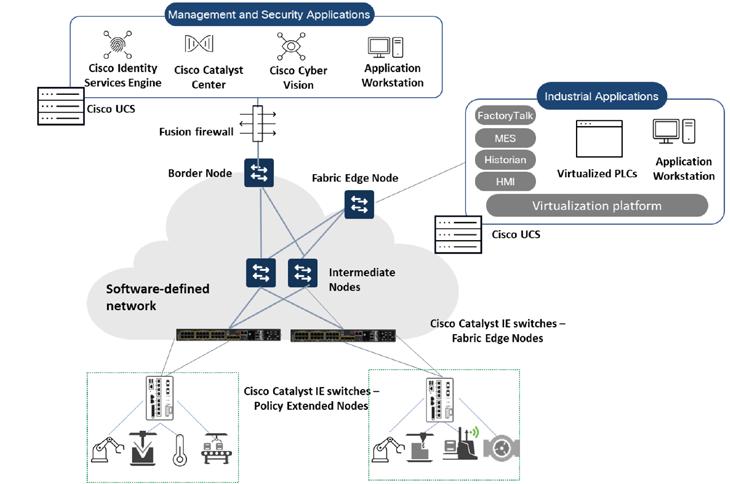
on industrial networks. Deployment of AI powered vision systems to detect defects and abnormalities also imposes high-bandwidth requirements on such networks,” Bhargava said.
Latest generations of industrial networks
Bhargava added that dependency on industrial networks is clearly increasing rapidly. In response, vendors such as Cisco, working in conjunction with automation companies and machine builders, are evolving their network infrastructure offerings to help operations modernize to enable their virtualization, motion control, and AI strategies.
A recent ARC Advisory Group’s ARC View reported that growth of industrial networking is driven by three needs: cybersecurity, IT/ OT partnership, and AI-readiness. This is in keeping with the 2024 State of Industrial Networking survey conducted by Cisco. Both pointed to Cybersecurity as organizations’ top concern, who are now preferring measures such as visibility, segmentation, and secure remote access capabilities built right in the network to keep their operations secure.
Similarly, another survey conducted by Harbor Research on the business value of IT/OT partnership shows 15% to 35%
improvements in operational productivity, 10% to 30% reductions in cybersecurity risks, and 15% to 30% reductions in time to market for new products and innovations. “End users are increasingly opting for networks that fulfill the needs of both IT and OT to foster their collaboration,” Bhargava said. “Finally, to make their operations AI-ready, end users require their network to be highly resilient, with low-latency high-bandwidth transport of time-sensitive data between machines, controllers and software applications residing in data centers and the cloud.”
Controller trends
Bhargava said that virtualization technology has dramatically changed the way IT resources are used, and services are delivered, enhancing efficiency, flexibility, and scalability. But up until recently, virtualization had yet to impact industrial operations in any significant way. IACS hardware resources in these environments have continued to exist as discrete resources. With digitization, the number of such hardware resources has risen rapidly and so has the time and expense of monitoring, updating, and troubleshooting them, which could require extended downtimes and result in productivity losses.
Therefore, the trend of control system
virtualization is poised to eliminate the many small hardware devices in favor of more agile software applications residing within hyperconverged infrastructure (HCI). The numerous resulting benefits include more scalable and agile operations, faster development of new features, reduced maintenance costs, more sustainable operations, and cost (both OpEx and CapEx) reduction.
The migration to virtualized controller is not possible without a supporting Layer 3 network through which Layer 2 protocols can be tunneled.
Software solutions
“Modern operations are incorporating software solutions now more than ever. Software at all levels – from virtualized PLCs and other hardware, applications running within networking equipment, network management and security to cloud applications are contributing to designing and building the next generation of machine control networks,” Bhargava said.
He added that management software that governs the network equipment is a key part of machine control networks. Intelligent management systems can dramatically reduce downtime by monitoring the network and
Figure 1: A secure scalable network fabric for machine control.

“With built-in security and outbound-only connections, modern controllers act as secure gateways, allowing machines to send data safely to the cloud without exposing control systems to cyber threats. In today’s factories, this isn’t optional; it’s a must,”-- Dan White, Director of Technical Marketing for Opto 22.
resolving any potential issues quickly. These systems also help scale the network and thereby operations faster and making them more flexible.
Edge software running on networking equipment also plays a key part. Visibility software such as Cisco Cyber Vision runs on Cisco switches and routers and can identify connected assets, traffic patterns, and security vulnerabilities, avoiding copying and transporting all traffic to another server. Edge applications can also perform timesensitive functions close to data sources and destinations for faster decision making.
Finally, applications such as MES and ERP run in datacenters and cloud, integrating various business processes, and monitoring and controlling manufacturing processes in real-time, providing data on production performance, quality, and inventory.
Opportunities and challenges
Bhargava said that automation engineers are navigating a complex landscape of opportunities and challenges. Opportunities in innovation that have the power of completely transforming existing operations abound. Software replacing hardware now makes each part of the process open to easier improvements by simply updating the software. Software applications in datacenters and the cloud also provide opportunities to optimize processes, perform preventive maintenance, and increase sustainability, among other benefits.
“The challenge is, of course, in building a resilient, deterministic, and secure
network that can provide the low-latency, high-bandwidth communications required for machine control in a software-driven environment,” Bhargava said.
Cisco has recently published a solution brief detailing the networking and security requirements for control systems virtualization.
Download Solution Brief
More Open, But More Secure
Key real-time data access, simplified connectivity and stronger security
According to Dan White, Director of Technical Marketing at Opto 22, “Machine control networks are shifting toward real-time data access, simplified connectivity, and stronger security.”
White told the Industrial Ethernet Book at the key technology trends are “More Open, But More Secure” and that factories are using built-in cybersecurity features in newer edge devices to secure data coming from critical systems. At the same time, they’re making data more accessible by moving from closed, proprietary networks to standard protocols like OPC UA, MQTT Sparkplug, and REST APIs. Other technology megatrends that White identified include:
OPC UA: uses an open poll/response framework with broad driver support, making it a powerful tool for collecting and unifying data from legacy PLCs across different brands and protocols.
MQTT Sparkplug: uses a publish/subscribe model, reducing network load by sending data only on change. Its outbound-only, encrypted connections enhance security, making it ideal for IIoT applications that need efficient, real-time data exchange.
REST APIs: provide a simple, flexible way to exchange data between industrial and enterprise systems. Widely used in IT, they power web services, cloud applications, and software integration. Their broad adoption makes them ideal for bridging OT and IT, enabling secure, on-demand access to machine data without proprietary protocols.
Technology for factory automation
“Factories are getting cleaner, more structured data thanks to open protocols, modern security, and better data modeling. And with edge analytics processing data at the source, both operators and machine builders can make faster, smarter maintenance decisions to keep equipment running,” White said.
He added that end users are using real-time machine monitoring and anomaly detection to catch issues early, before they turn into failures. They’re reducing unplanned downtime and improving overall equipment effectiveness (OEE). OEMs are building remote access into machines, so they can diagnose problems and update systems without costly site visits.
Megatrends for controls
“Modern controllers do more than just execute logic—they handle data processing,

"Two
of the biggest overarching trends we are seeing is the push for on-machine control and data. The push for on-machine devices has driven the need for new hybrid cabling to allow for networking and high power to simplify installation and setup. On the data front, we’re seeing devices publishing more data to controllers and beyond," -- Justin Garski, Americas OEM Segment Manager, Rockwell Automation.
security, and connectivity at the edge of the network,” White said.
Controllers also provide more comprehensive solutions that address a broad range of issues:
Data Processing: Modern controllers standardize and structure data to fit into a Unified Namespace (UNS), ensuring a single source of truth across systems. They add units, filter out irrelevant data, and use User-Defined Types (UDTs), which group related data into reusable structures, making integration and scaling across systems easier.
Security: Built-in controller cybersecurity features include zero-trust architecture, user authentication, support for SSL/TLS security certificates, VPN access, outbound-only communication to reduce open ports, and firewall-based network segmentation.
Connectivity: Controllers now support multiple open protocols for seamless integration, including MQTT Sparkplug, OPC UA, REST APIs, Modbus, and EtherNet/IP.
Modern controllers also make life easier for OEMs, system integrators, and end users:
• OEMs can build machines that plug right into any system without custom engineering, support secure remote access, and work with any SCADA, MES, or cloud platform—no vendor lock-in.
• System integrators can securely integrate machines and systems from various manufacturers, more easily providing customers the data they need.
• End users get clean, structured data for real-time monitoring, predictive maintenance, and analytics. Instead
of siloed machines and messy data, they get a clear view of operations to optimize production and cut downtime.
“With built-in security and outboundonly connections, modern controllers act as secure gateways, allowing machines to send data safely to the cloud without exposing control systems to cyber threats. In today’s factories, this isn’t optional; it’s a must,” White concluded.
Software solutions
He added that, beyond built-in support for IIoT protocols and cybersecurity, today’s edge devices offer flexible programming environments. Engineers can choose between IEC 61131-3, the standard for PLC programming in OT, and higher-level languages like Python, JavaScript, and C++, which are widely used in IT for tasks like data processing, analytics, and cloud integration.
SCADA software vendors now offer unlimited licensing models, eliminating tag-based pricing restrictions so manufacturers can scale up data collection and analysis without added costs.
“Edge devices are now capable of running containerized applications, allowing software to be deployed in isolated environments without interfering with core control processes. This makes it easier to update, maintain, and scale applications across multiple systems while reducing downtime and hardware dependencies,” White said.
Opportunities and challenges?
“The biggest opportunity is smarter
machines—reducing downtime, extending machine life, and cutting service costs with remote troubleshooting,” White said. “Manufacturers are using real-time monitoring and AI-driven analytics to make this happen.”
“The biggest challenge is legacy integration. Most factories still rely on older machines that weren’t built for modern networks, and replacing them isn’t practical. Smart edge devices solve this problem by securely connecting legacy equipment with OPC UA, MQTT, and other open protocols to unlock valuable data and keep systems relevant without costly upgrades.”
On-machine devices, effective data collection
Push for on-machine control and data.
Technology megatrends are shaping machine control networks for factory automation applications, as machine control, motion control and device networks are evolving to provide effective solutions.
“Two of the biggest overarching trends we are seeing is the push for on-machine control and data,” Justin Garski, Americas OEM Segment Manager at Rockwell Automation told IEB. “The push for on-machine devices has driven the need for new hybrid cabling to allow for networking and high power to simplify installation and setup. On the data front, we’re seeing devices publishing more data to controllers and beyond. The true challenge remains in the contextualizing of this information into meaningful actions. I’d

"Several technology megatrends are shaping machine control networks for factory automation. IIoT enables real-time data collection and analysis, enhancing predictive maintenance and operational efficiency. AI drives analytics to optimize production processes, improve quality control, and enable autonomous decision-making." -- Matthias Schulz, Marketing Manager, Siemens.
look for that to improve and be the focus in the near future.”
Technology benefits
What asked specific technology benefits are factory automation end users and OEM machinery builders incorporating into the latest generations of industrial networks and machinery, Garski responded that priorities have shifted.
“In the past we’ve talked a lot about network determinism, but that has now shifted to time synchronization, traffic management and cyber security. Other similar manufacturers are building these features into products and networks to make connecting things easy, more reliable and safer,” Garski said. “Occasionally engineers will opt for an ’IT-first’ setup on their machine networks, and it frequently causes issues. It’s essential that these configurations and features are set up correctly for seamless integration.”
Garski added that most controllers today are Ethernet-based by default. That could be EtherNet/IP, EtherCAT or Profinet. These networks are now being extended into two-wire networks in control panels in addition to the traditional cabling for field devices. Beyond that, we are seeing IO Link gaining momentum as a machine level network, which allows for deeper diagnostics and intelligence from devices. This helps customers bring intelligent machines to life faster and, if done correctly, can aid troubleshooting and maintenance.
Opportunities and challenges?
When asked about opportunities and challenges for automation engineers, here is how he responded.
“The opportunities are in building more intelligent machines that start to heal and adjust themselves while also connecting to larger data models. This pushes toward a truly autonomous factory and presents a tremendous opportunity for engineers and their companies to be the first to realize the value of autonomous operations,” Garski said.
“The challenge is that controls and machines continue to get more complex. What we used to be able to troubleshoot with a simple multimeter has now become a bit stickier with network tools, software engineers, databases and IT teams,” he added. “That complexity can be time consuming to implement and modify. The good news is, if you choose the right partner and ecosystem it doesn’t need to be complex.”
Software-defined automation
Seamless integration of control functionality, automated backup and secure remote access.
“Several technology megatrends are shaping machine control networks for factory automation,” Matthias Schulz, Marketing Manager at Siemens told IEB.
“IIoT enables real-time data collection and
analysis, enhancing predictive maintenance and operational efficiency. AI drives analytics to optimize production processes, improve quality control, and enable autonomous decision-making. Edge computing processes data at the edge, reducing latency and enhancing real-time decision-making capabilities. Robust cybersecurity measures are essential to protect interconnected systems from cyber threats,” Schulz said.
“Machine control, motion control, and device networks are evolving through softwaredefined automation solutions, which shift focus from hardware-based devices to softwaredefined functionalities, enabling flexible and scalable automation. This approach allows for seamless integration of control functionality, automated backup, and secure remote access no matter if converged on a central data structure or directly at individual machines,” Schulz added.
By leveraging software-defined automation, factories can increase uptime and maximize productivity. These advancements collectively drive the evolution of factory automation, ensuring efficient, secure, and adaptive manufacturing and production environments.
Technology benefits
Schulz said that enhanced connectivity through Industrial Ethernet and wireless technologies ensures seamless communication between devices, improving data flow and system integration. Real-time data processing via
“The

-- Martin Rostan, Executive Director,
edge computing allows for immediate analysis at the source, reducing latency and enhancing decision-making capabilities. Predictive maintenance, powered by IIoT sensors and AI-driven analytics, predicts equipment failures before they occur, minimizing downtime and maintenance costs. Advanced cybersecurity measures, including network segmentation and zero trust architectures, protect against cyber threats. Software-defined automation solutions provide scalable and flexible automation, allowing for easy integration of new devices and technologies. Additionally, smart energy management systems optimize power usage, reducing operational costs and environmental impact.
Control trends
At the controller level, technology megatrends are shaping the development of new machines.
“Machine builders are adopting modular, virtualized control platforms that provide greater flexibility and scalability through software. These architectures enable rapid central configuration, customization and adaptation to changing production needs, speeding time-to-market,” Schulz said.
‘The integration of advanced control algorithms and AI is also empowering new levels of machine autonomy and optimization. Predictive maintenance, adaptive motion control, and self-diagnostics enhance performance, reliability and productivity –all driven by intelligent software-defined
automation,” he added.
Virtualization and containerization
Schulz said that virtualization and containerization technologies are enabling more flexible, scalable control architectures.
By decoupling control software from dedicated hardware, machine builders can rapidly configure and deploy control systems to meet evolving application needs. This modular, software-defined approach simplifies maintenance and upgrades.
Advanced control algorithms and AI are being integrated into machine control software to enhance autonomy and optimization. Predictive maintenance, adaptive motion control, and self-diagnostics leverage intelligent software to improve machine performance, reliability, and productivity.
Connectivity and data integration solutions are bridging the gap between IT and OT systems. This allows machine control networks to seamlessly share data with enterprise systems, enabling data-driven decision making and optimization across the production lifecycle.
Additionally, edge computing and IIoTenabled device networks are transforming how operational data is collected, processed and utilized. Furthermore secure, software-defined edge solutions empower real-time control.
Opportunities and challenges
“Software-defined automation is a game-
changer,” Schulz said. “It allows us to create highly flexible, scalable control architectures based on IT methods and mechanisms that can be rapidly configured and deployed. This modular approach simplifies maintenance and upgrades, extending the lifecycle of our automation systems.”
Schulz added that integrating advanced control algorithms and AI next to machine control software also presents exciting possibilities. Predictive maintenance, adaptive motion control, and self-diagnostics can significantly improve machine performance, reliability, and productivity.
“The challenges lie in managing the increased complexity of these intelligent, software-driven control networks. Ensuring secure, deterministic communications, as well as maintaining robust edge computing capabilities, are critical to realizing the full potential of these new solutions,” he concluded.
EtherCAT solutions
A focus on PC-based control, consistent performance and cyber security solutions.
“When it comes to technological megatrends, everyone immediately thinks of AI – and AI is certainly rapidly increasing its influence on how we program our machine controllers, how we evaluate machine data, and then also on the engineering of our control systems,”
megatrend on the controller level that has taken place in recent years is the change from the classic PLC to PC-based control. This not only means openness, access to far more software solutions, and the possibility of integrating previously distributed tasks into a single controller, but above all, almost unlimited computing power and the perfect scalability of this computing power."
EtherCAT Technology Group.

“Controls engineers have one of the toughest jobs in an already challenging factory environment. New technologies like SPE, virtual controllers, and AI are set to take some of the burden off their shoulders. Specifically, SPE will allow for increased device connectivity for increased device and communication diagnostics to better troubleshoot problems," -- Steve Fales, ODVA Director of Marketing.
Martin Rostan, Executive Director for the EtherCAT Technology Group told the Industrial Ethernet Book recently.
“However, the requirements for machine control networks are hardly changing due to the use of AI: short and deterministic cycle times, stable and precise synchronization, high data throughput, robust communication and simple configuration are still in demand,” he said. “In other words, all the properties that EtherCAT has always provided. And with EtherCAT G, we are extending our technology to applications that require even more data throughput – for example, to supply machine learning algorithms with data.”
“Another megatrend is cyber security, not least driven by the European Cyber Resilience Act, which will be followed in a similar form on other continents. Here we see that the architecture that EtherCAT has always favored – namely the clear separation of the machine control network from the factory network – is now also being adopted by those who previously tried to advertise completely meshed architectures,” Rostan said.
Technology for factory automation
“’The latest generation of industrial networks’ is a good keyword. I doubt that end users and OEM machine builders are really interested in ever-new ‘generations’ of industrial networks. Such ‘generations‘ mean a new technology
version and thus always a break in the technology used, which is mainly associated with disadvantages for users: not only do new tools and new devices have to be used, but above all, the maintenance of existing systems becomes complex and cumbersome due to different protocol versions,” Rostan said.
He added that, when replacing devices, the replacement device must first be adapted to the protocol version used at the time, which does not always work with a firmware downgrade: a new version often also requires new hardware, sometimes even new infrastructure devices such as switches.
“With EtherCAT, we avoid these problems completely by never changing EtherCAT, but always only expanding it in a fully downwardcompatible way. This means that users can always replace an old device with a new one without having to make any changes. Feedback from users shows us that this is reason enough for many to choose EtherCAT. What's more, we are maintaining this full backwards compatibility with the introduction of EtherCAT G,” Rostan said.
PC-based controls
“The megatrend on the controller level that has taken place in recent years is the change from the classic PLC to PC-based control,” Rostan said. “This not only means openness, access to far more software solutions, and the possibility
of integrating previously distributed tasks into a single controller, but above all, almost unlimited computing power and the perfect scalability of this computing power. And with that, motion control and device networks are becoming more important. Where the PLC's cycle time used to be the determining factor for the control architecture's performance, this is no longer a limiting factor in the age of PC-based controllers.”
And where the bus system's cycle time used to almost always be shorter than the PLC's cycle time, this is no longer the case: with PC-based controllers, it is easy to achieve control cycles well below a millisecond. The problem is that the fieldbuses and almost all industrial Ethernet solutions can no longer keep up, and therefore form the overall limitation of the control performance. Thanks to its unique functional principle and the resulting outstanding performance, EtherCAT also offers the solution here: EtherCAT not only matches the performance of modern PC-based control, but even surpasses it, and thus does not form a bottleneck.
The importance of software solutions
“Let me address the software in machine control networks that is perhaps most underestimated: the protocol stacks in the fieldbus devices. The time it takes for the
messages to pass through the protocol stacks is not included in the cycle time calculation and is therefore often neglected,” Rostan said. “However, with many Industrial Ethernet technologies, the protocol stacks are very large, and it takes a correspondingly long time for the data to make it through the stack to the local application – in some systems, the delay caused by the stack is longer than the cycle time of the controller discussed earlier! This is not the case with EtherCAT, where the complexity of the technology is completely hidden in the chip hardware, leaving the remaining software extremely lean. This results in very short processing times and further performance gains compared to other technologies.”
Opportunities and challenges
“Well, with the right choice of machine control network, automation engineers can make full use of the controller performance,” Rostan told IEB. “Shorter cycle times lead to more precise control and thus to better results in terms of the quality of the manufactured products. And they lead to shorter reaction times and thus to improved system throughput, because the controller has to wait less time for sensor data before it can initiate the next step.”
He concluded that the challenges include the IT know-how required for many Industrial Ethernet systems. Although EtherCAT is Ethernet-based, it is not based on IT protocols and should therefore not be considered an IT network. Accordingly, users do not need to be an IT expert with experience in switch and router configuration to use EtherCAT.
Pervasive connectivity
Ethernet providing better solutions down to the device level
According to Steve Fales, ODVA Director of Marketing, pervasive connectivity being driven by the Industrial Internet of Things (IIoT) is bringing Ethernet down to the device level of the factory floor. Previously low cost and limited footprint sensors and devices were only capable of providing a simple analog electrical signal that offered limited information about the process and device status.
“The next advancement was superimposing a digital signal on top of the analog signal to provide diagnostic information like what HART devices offer in process automation. From there, IO-Link further advanced what was possible with small sensors and devices by enabling point to point digital communication,” Fales told the Industrial Ethernet Book recently.
“Now, Single Pair Ethernet (SPE) offers Ethernet down to low-cost devices such as RFID sensors, contactors, and push buttons.
This has been made possible through UDP only Ethernet communication, use of single twisted pair cabling, and standardization of low cost SPE semiconductor chips. SPE comes in many different forms such as Ethernet-APL that utilizes 2-WISE for intrinsic safety and 10BASE-T1L for long cable lengths of up to 1,000 meters that are necessary for the process industries,” Fales said.
He added that EtherNet/IP In-Cabinet uses 10BASE-T1S SPE for short distances to connect contactors, push buttons, and motor starters in a cabinet together with a single flat cable. General purpose SPE (10BASE-T1S) is also being used for applications like RFID readers in distribution warehouses.
Specific technology benefits
“There are many benefits to adopting SPE including reducing commissioning time from minutes to seconds, enabling diagnostics that provide device, network, and process status, and being able to support multiple process variables and faster updates via increased bandwidth,” Fales said.
End users and machine builders are incorporating SPE into CNC and other machines to make it easier for younger technicians to interact with the devices based on their Ethernet training and familiarity. Cabinet builders are utilizing EtherNet/IP In-Cabinet to reduce the amount of wiring and construction time required while end users benefit from the newly available diagnostics that can alert operators to a fault quickly.
“Sustainability is another advantage that SPE offers with simpler cabling and greater control of device usage. Finally, the diagnostic information that SPE unlocks in lower-level devices can assist in machine and factory optimization efforts powered by analytics and AI,” Fales said.
Machine control trends
“The next major trend for machines at the controller level will be the usage of virtual controllers. Virtual controllers offer the benefits of being able to easily update security patches and to run control program backups on different servers in case of hardware failures,” Fales said.
Remote management will make it easier to make program changes and to troubleshoot issues. This also makes it possible for IT to manage the maintenance of the virtual controller environments, freeing up controls engineers to do more value-added work with process optimization. Additionally, virtual controllers will make it easier to move data to the edge and cloud for optimization analysis and action.
While virtual controllers aren’t appropriate for all applications such as those with high security, safety, and reliability requirements, they are poised to enable greater IT/
OT convergence for simple automation applications. It’s also good news that Industrial Ethernet networks including EtherNet/IP are already prepared for usage by virtual controllers by virtue of being based on IEEE standards and utilizing TCP/IP communication.
Next generation machine control networks
Fales said that embedded software interfaces in controllers allow users to utilize AI to leverage their existing process data from industrial networks like EtherNet/IP for tasks such as predictive maintenance, energy reduction, and process improvement. The controller software reduces the time needed to collect the relevant data in an appropriate format.
All types of analysis significantly benefit from data that doesn’t have duplicates, missing values, different scales, and other errors. It can take a lot of effort to complete data preparation and cleaning when doing manual analysis work. This type of controller software can also help the user by recommending the appropriate AI model for the desired task. While many AI models are open source and utilize common program language such as Python and R, it requires experience to select the appropriate AI model for a given task. Finally, the AI controller software can help to feed the optimization results directly back into the process for much quicker implementation, results, and improvement iterations.
Opportunities and challenges
“Controls engineers have one of the toughest jobs in an already challenging factory environment. New technologies like SPE, virtual controllers, and AI are set to take some of the burden off their shoulders,” Fales said. “Specifically, SPE will allow for increased device connectivity for increased device and communication diagnostics to better troubleshoot problems. It’s much easier to know exactly where the problem is when a machine stops working in the middle of the night.”
His logic is that virtual controllers will make it much less burdensome to provide security updates across an entire plant. Virtual controllers will also make it possible for IT to help with OT network management to allow controls engineers to focus on ways to improve OEE, quality, and cost reduction. Additionally, controllers with embedded AI interface software will allow for greater abilities to tackle tough problems when deadlines are tight. This includes important tasks such as predictive maintenance that can help improve uptime and energy reduction that can lower costs and help meet sustainability targets.
Al Presher, Editor, Industrial Ethernet Book
6G vision targets industry collaboration and connectivity
The Wireless Broadband Alliance's 6G Vision calls for greater industry collaboration if ubiquitous connectivity is to be achieved. Its vision statement outlines WBA goals for 6G and recommendations to ensure the 6G opportunity resonates beyond the technical community, appealing to policymakers, businesses and end-users.

THE WIRELESS BROADBAND ALLIANCE (WBA), the global industry body dedicated to driving the seamless and interoperable service experience of Wi-Fi across the global wireless ecosystem, has released an introductory report on 6G’s potential transformative role titled, “6G - WBA Vision Statement.”
The statement calls for greater collaboration between all stakeholders if 6G is to deliver on its promise, and details five key vision points for 6G, to achieve ubiquitous connectivity that comprises Wi-Fi, cellular, non-terrestrial networks, IoT LPWANs, and other wireless technologies at its core.
Wi-Fi and cellular are the two most adopted wireless broadband technologies in the world, available in billions of devices
and used daily by billions of users all around the world. To date, both technologies have been evolving from the standards point of view, on independent paths, resulting in separate technical standards, architectures, and industry ecosystems.
While the cellular standards organizations have made efforts to integrate these systems and positive progress has been made, with converged solutions like Wi-Fi Calling or SIM-based seamless Wi-Fi authentication, broader real-world adoption and implementation have lagged for reasons including the need to harmonize fragmented user experiences, complexity of non-3GPP access methods, costs related to implementation complexity, and the need to learn from previous cellular generations.
WBA Vision for 6G
Ubiquitous connectivity for all: Advocate for a wireless ecosystem where wireless networks collaborate rather than compete. This environment ensures uninterrupted experiences for users, regardless of environment, urban, rural or indoors.
Practical solutions for industry challenges: 6G should prioritize resolving industry pain points such as fragmented user experiences, costly network implementations, and inconsistent coverage. Realistic, scalable models that leverage Wi-Fi and cellular, and other wireless technologies, to address these issues effectively.
Cost and operational efficiency: Operators must balance increasing data demands with operational/energy efficiency to ensure
Early adopters of Wi-Fi 7 will include technology-driven industries and enterprises needing high-density, high-speed connectivity.
sustainability. Wi-Fi's cost-effectiveness can complement 6G to reduce CAPEX, operational costs and network densification, particularly indoors.
Targeted applications for impact: Unlike 5G's broad focus, 6G should concentrate on practical verticals like healthcare, smart cities, and industrial automation. These areas benefit most from reliable, low-latency, and seamless connectivity.
Global collaboration and standardization: Importance of industrywide collaboration, aligning Wi-Fi, cellular, among other technologies advancements through standards bodies like 3GPP, GSMA, IEEE, IETF, WBA and the Wi-Fi Alliance to avoid fragmentation and ensure interoperability.
Recommendations to address industry fragmentation
In addition to outlining its vision for 6G across the industry, the WBA is making three recommendations which it believes will help address fragmentation in the industry and contribute to successful outcomes for 6G:

Balance between service requirements and technology-driven solutions: A key consideration is whether 6G benefits from a customer-led approach rather than technology-led convergence efforts. While equipment manufacturers, both cellular and Wi-Fi vendors, drive many innovations in their respective technologies, operators may be better positioned to take a holistic, technology-agnostic view of customer needs and their own challenges. Operators can bring balance to the ecosystem by ensuring that solutions are designed with customer challenges and real-world use cases in mind, avoiding a technology-driven approach that may overlook cross-network requirements. The ecosystem needs a balanced approach where operators lead in defining end-user requirements while vendors contribute with specialized technology.
Download the full report.
labs would be to validate vendor innovations and produce viable industry solutions that address fragmentation, benefiting both operators and end customers. These efforts will ensure vendors across Wi-Fi, cellular, and other networks can prototype solutions that work seamlessly together.
• Leverage AI to optimize network selection and reduce operational overhead.
• Establish innovation labs for real-world testing and vendor collaboration.
The 6G - WBA Vision Statement was prepared with the input and support of the following WBA member organizations: AT&T, Airties, Boingo Wireless, Boldyn Networks, BT, Charter, Cisco, Comcast, HFCL, Intel, Reliance Jio, Telekom Deutschland and Turk Telekom.
JR Wilson, Vice President, Tower Strategy and Roaming at AT&T, WBA Chairman, said: “Our customers will measure the success of 6G by how well it meets their needs in the real world. At AT&T our focus is implementing solutions that best serve customers, with the right technology and user experience for every consumer and business use case, underpinned by our ability to support them operationally. The WBA 6G Vision Paper, highlights how important it is to meet those needs regardless of the technology concerned.”
Strategic role of the Wi-Fi in IMT-2030 and 6G development: Industry alignment will be critical in the 6G standards process by ensuring that convergence, particularly involving relevant access technologies like Wi-Fi, plays a key role in how 6G meets customer needs. This includes promoting multi-stakeholder engagement to align technical specifications with real-world user needs and ensuring that 6G development focuses on interoperability between access technologies.
Supporting innovation labs for 6G: Industry should support the creation of an "Innovation Lab" for 6G convergence to foster real-world convergence use cases, such as ATSSS, and support vendor Proof of Concept (PoC) and prototype development. The objective of these
Tiago Rodrigues, CEO of the Wireless Broadband Alliance, said: “Collaboration between cellular, Wi-Fi and other wireless technologies stakeholders, including operators, vendors, and vertical industry players, is crucial for the success of 6G. By centering its vision on densification, capacity, efficiency, and collaboration, the WBA aims to make 6G not just a technological leap but a practical solution for global connectivity challenges.”
Actionable steps
The WBA will be promoting several actionable steps to drive broad industry alignment, which it believes will ensure the 6G opportunity resonates beyond the technical community, appealing to policymakers, businesses, and end-users alike:
• Advocate for simplified, cross-network policies that focus on the end user experience.
• Develop frameworks for seamless identity management and access steering.
• Promote affordable and scalable solutions like Federated Roaming (e.g. OpenRoaming) and neutral host models for network densification.
Maria Cuevas Ramirez, Board Director, Wireless Broadband Alliance and Network Infrastructure Research Director at BT, said: “It is important that the 6G era brings together cellular, Wi-Fi, and non-terrestrial access in a more seamless fashion, to create a “network of networks” that delivers a great experience for customers. Collaboration will be critical to achieving this and we’re pleased to support the WBA Vision Statement for 6G which aims to identify and propose key enhancements to enable the industry to deliver on this ambition.”
Dr. Mehmet Ozdem, Director of Network Design and Service Management, Turk Telekom, added: “The convergence of 6G and Wi-Fi will enable interoperability between different communication protocols and architectures, creating a more efficient and user-centric ecosystem. This convergence will play a strategic role for operators by accelerating digital transformation. WBA will provide guidance and leadership in this area through its work with technology stakeholders and industry leaders.”
Download the “6G - WBA Vision Statement” for full details of the WBA’s vision, view on industry challenges, recommendations, and an analysis of multi-access and agnostic services by clicking below.
Technology report by Wireless Broadband Alliance.
Download Report
Do you actually know… EtherCAT?
How exactly does EtherCAT work, what does the protocol do and how does it differ from comparable systems?
This first of a series of articles in the Industrial Ethernet Book will refresh your knowledge of EtherCAT technology.
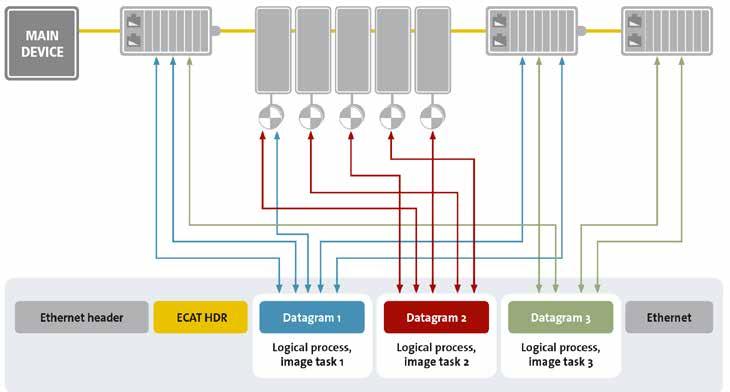
ETHERCAT, WITH AROUND 80 MILLION NODES IN the field and a user organization of over 8000 members behind it, is an established communication standard in industrial automation worldwide, a good 22 years after its introduction. But how exactly does EtherCAT work, what does the protocol do and how does it differ from comparable systems? We will use a series of articles in the Industrial Ethernet Book to refresh your knowledge of EtherCAT technology.
Processing on the fly – how it works
Traditional networks in automation are characterized by small amounts of data per node; usually less than the minimum payload of an
Ethernet frame. One frame per node, direction and cycle therefore does not make optimum use of the available bandwidth and thus limits the performance of the entire system.
This is where the functional principle of EtherCAT comes in. With EtherCAT, the nodes read data intended for them from the frame and write their own data back into the same frame as it passes through the node. Standard Ethernet frames are used, the size of which is usually sufficient to transport all the process data required for the cycle in one telegram.
Furthermore, the network nodes can act as connectors and have more than two ports, which is why no switches or hubs are required. The last node sends the telegram back to the
controller using the full-duplex function of Ethernet. Only the controller, the EtherCAT MainDevice, actively sends frames, which avoids delays caused by collisions and ensures the real-time capability of the system. All that is required is a standard Ethernet MAC, so that any controller with an Ethernet port can become an EtherCAT MainDevice via software.
On the side of the connected field devices, called EtherCAT SubDevices, EtherCAT SubDevice Controller Chips are used, which integrate all time-critical functions in hardware, which in turn avoids delays caused by large software stacks.
In terms of overall network performance, EtherCAT’s functional principle overcomes

Figure 1: With EtherCAT, process data is inserted into the datagram as it passes through.
Figure 2: EtherCAT uses standard Ethernet frames in accordance with IEEE 802.3.
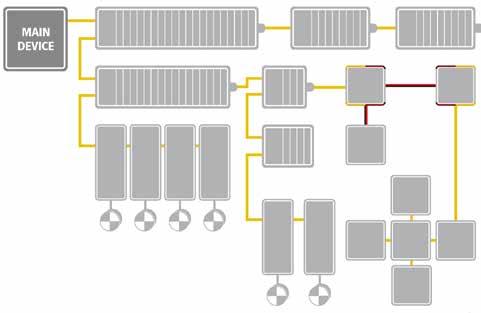

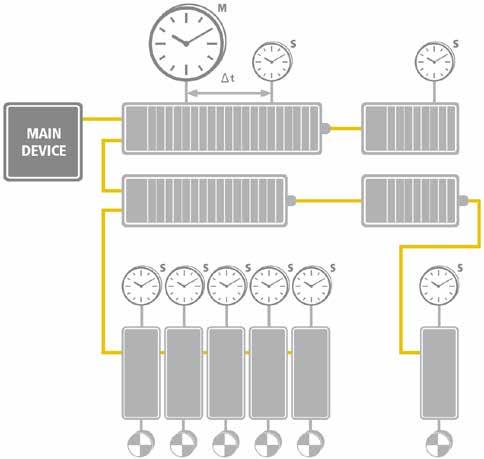
the three biggest limiting factors, namely insufficient bandwidth utilization and delays caused by switches and large software stacks.
Fast, flexible and precise
SOURCE:
Another feature of EtherCAT is its versatility. As the protocol does not require hubs and switches, as described above, there are practically no restrictions in terms of topology. Line, tree, star and all conceivable combination of these are possible. Thanks to automatic link detection and Hot Connect functionality, nodes and segments can be disconnected and reconnected during operation – even at a different location and without disrupting the network.
Line topology can be closed to form a ring for the purpose of cable redundancy, which enables applications with high availability requirements. All the controller needs on the hardware side is a second Ethernet port; the field devices themselves support cable redundancy from the outset.
There are also different transmission variants for different requirements. If required, not only data but also power can be transmitted on just one line. With an almost unlimited number of network participants per segment, there is no need for local expansion buses and all modules benefit directly from the EtherCAT performance.
Also of great importance for the performance of a network is the precision of the synchronization of the connected devices. Compared to fully synchronous communication, whose quality suffers immediately from communication errors, a solution with high synchronized clocks distributed across the network enables high jitter tolerance in the system. EtherCAT follows this approach and uses distributed clocks (DC) for this purpose.
The clocks in the nodes are synchronized in hardware, whereby the time of the first synchronously operating node is distributed cyclically to all other clocks in the system, which are set exactly to this reference clock. As the information from the reference clock arrives late at the other clocks in the cycle due to propagation delays on the cable and in the nodes, the delay is measured and compensated individually for each node in order to achieve synchronization as well as simultaneity. And so, with EtherCAT the latter is significantly less than 1µs, just like the jitter of the clocks. And the EtherCAT MainDevice is also relieved when using the distributed clocks, as it only has to ensure that the EtherCAT frame is sent early enough before the clock signal in the nodes triggers the outputs to be set.
Christiane Hammel, EtherCAT Technology Group.
Figure 4: Simple cable redundancy with standard EtherCAT SubDevices.
Figure 3: Flexible topology: line, tree, or star.
Figure 5: The synchronization of the participants is completely hardware-based; runtime delays are calculated and compensated.
Motor encoders for next-gen sustainable applications
Deep domain expertise is aiding in the design of industrial motor encoders and networks of the future. Integrating asset health insights is made easy with tiny and powerful microcontrollers, magnetic sensors improve reliability, reduce size and weight, and are easier to integrate compared to optical or resolver sensing solutions.
MOVING FROM FIXED SPEED TO VARIABLE speed motors with position and current feedback provides a path to huge process and energy savings. This article provides an overview of motor encoders (position and speed), including types and technologies, and application use cases to help create next-generation sustainable solutions.
It also answers key questions such as what encoder performance metrics are the most critical for my system. Key future trends for electronics used in encoder applications will be discussed, including machine health monitoring, intelligence, and robust longer life sensing. Finally, we’ll explain why complete signal chain designs are fundamental for designing next-generation motor encoders.
Motor encoder performance metrics, trends, and electronics
After reading this article, you should be able to answer the following key questions:
• What is an encoder and how does it improve the performance of my inverter and motor-driven system?
• What encoder performance metrics are the most critical for my system? After reading this article, you will understand how to match encoder resolution, accuracy, and repeatability specifications to motor and robot system specifications.
• What are the electronics commonly used in encoders, and what are the future trends? After reading this article, you will understand how machine health monitoring, edge intelligence, robust sensing, and high speed connectivity are enabling future encoder designs.
Closed-loop motor control feedback system
There has been a steady and constant move from traditional grid-connected motors to inverter-driven motors in the last couple of decades. This has been, and is continuing to be, a significant transition in industrial rotating equipment and has resulted in huge process and energy savings with motors and end equipment being used more efficiently. Higher quality motor control performance with variable speed drives and servo driven systems now offer enhanced quality and synchronization for the most demanding applications. Motor performance and
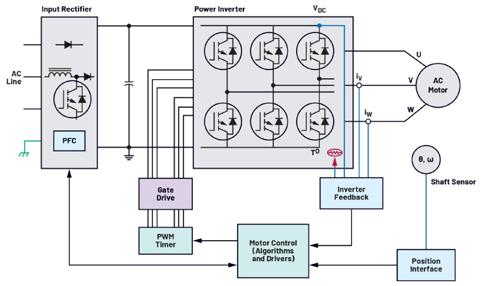
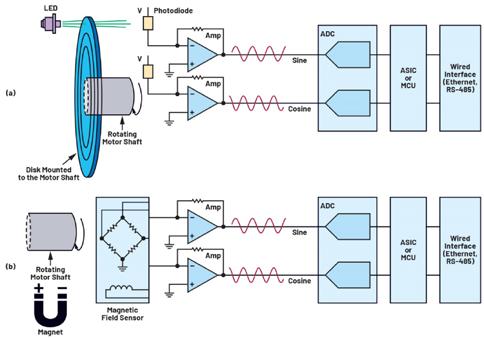
efficiency are improved by using the power inverter, high performance position sensing, and current/voltage closed-loop feedback for the power stage as shown in Figure 1.
Open-loop speed control of motors is possible by applying a variable frequency voltage to the motor using pulse width modulation in the inverter. In steady state
or slowly varying dynamic conditions, this will work reasonably well, and many motor drives in lower performance applications utilize open-loop speed control, without requiring an encoder. However, there are several disadvantages to this approach:
• Speed accuracy is limited as there is no feedback
Figure 1. The closed-loop motor control feedback system.density, high-speed connectivity.
Figure 2. (a) An optical encoder and (b) a magnetic encoder.
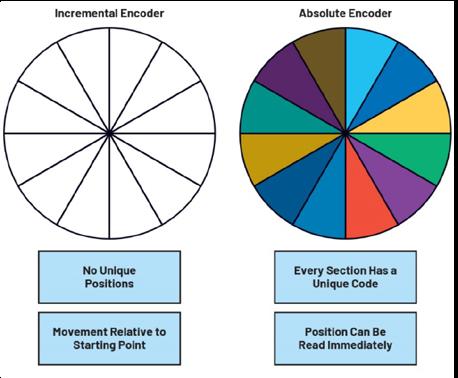

SOURCE: ANALOG
• Motor efficiency is poor, as the current control cannot be optimized
• Transient response must be strictly limited so that the motor does not lose synchronization
What is a position encoder?
An encoder provides closed-loop feedback signals by tracking a rotating shaft speed and position. Optical and magnetic encoders are the most widely used technologies, as shown in Figure 2. In general purpose servo drives, encoders are used to measure the shaft position, from which the drive rotational speed is derived. In robotics and discrete control systems, precise and repeatable shaft position is required. Optical encoders consist of a glass disk with fine lithography slots. Photodiode sensors detect light variation as it passes through or is reflected off the disk. The analog output of the photodiode is amplified and digitized and then sent over wired cabling to the inverter controller. Magnetic encoders consist of magnets mounted to the motor shaft, with a magnetic field sensor providing sine and cosine analog output, which is amplified and digitized. The optical and magnetic sensor signal chains are similar as shown in Figure 2.
Motor Encoder Types, Technologies, and Performance Metrics
Absolute single-turn encoders return the absolute position, either within mechanical or electrical 360° once power is applied. The position of the motor shaft can be read immediately. Absolute multiturn encoders include both absolute functions and count the number of 360° turns. In contrast, incremental encoders provide position relative to the rotation starting point. Incremental encoders provide an index pulse to indicate 0° and a single pulse to count turns or a dual pulse to give direction information.
The resolution of an encoder is the number of positions that can be distinguished per 360° rotation of the motor shaft. In general, the highest resolution encoders use optical
encoder
Figure 3. Encoder types.
Figure 4. Angular repeatability at the motor encoder (θm) and the joint encoder (θj), with the robot reach (L).
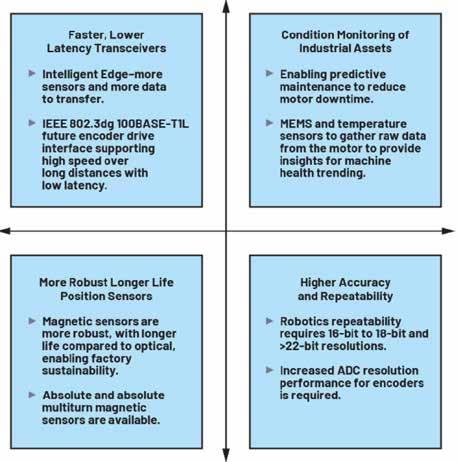
technology, while medium resolution/high resolution encoders use magnetic or optical sensors. Resolvers (rotary transformers) or Hall sensors are used for low to medium resolution encoders. Optical or magnetic encoders use high resolution signal conditioning. The majority of optical encoders are incremental. Encoder repeatability is a key performance metric and is a measure of how consistently the encoder returns to the same commanded
position. This is critical for repetitive tasks such as robotics or pick and place machines for semiconductor placement during PCB manufacture.
The importance of motor encoder accuracy and repeatability
Pick and place machines/robots are commonly utilized automation machines in the food packaging and semiconductor
SOURCE: ANALOG DEVICES
manufacturing industries. A machine or robot with high accuracy and repeatability is required for process efficiency. The accuracy, repeatability, and efficiency are achieved using high performance motor encoders.
Figure 4 illustrates an encoder use case in robotics. Motors drive each joint in a robot arm via precision speed reduction gearboxes. The robot joint angles are measured via a precision motor-mounted shaft angle encoder ( θ m) and often additional arm-mounted encoder (θj).
For robots, the main performance specification listed on data sheets is

repeatability and typically the order of magnitude is at a submillimeter level. By knowing the repeatability specification and the robot reach, you can extrapolate back to the rotary encoder specifications.
The angular repeatability ( θ ), required at the joint encoder, can be derived from trigonometry: tan inverse of robot repeatability divided by reach.

Multiple joints combine to achieve the overall robot reach. The sensor should have
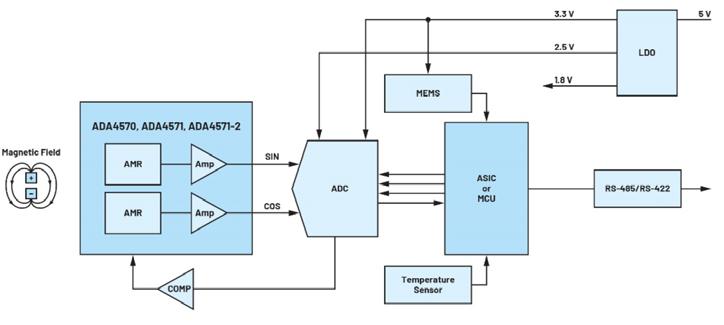
Figure 5. Encoder trends and the technologies that will enable these trends.
Figure 6. An AMR sensor system.
Figure 7. Magnetic encoder (AMR) signal chain.
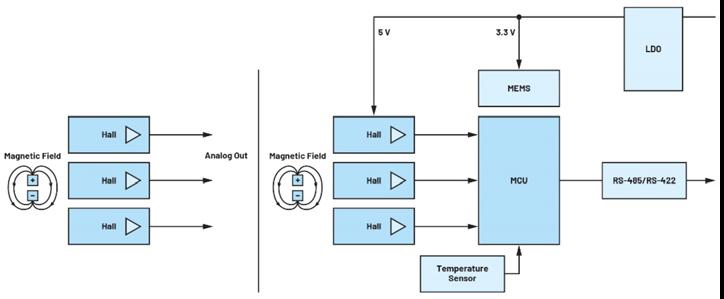
a higher performance than the target angular accuracy. The repeatability specification per joint must be improved, and a factor 10 improvement is assumed here. For the motor encoder, the repeatability is defined by the gearbox ratio (G).
For example, 20-bit to 22-bit repeatability specifications are required in robotic systems for the joint encoder while 14-bit to 16-bit resolutions are necessary for the motor encoder.
Future trends for motor encoder technologies
Future encoder trends and technologies that will enable these trends are described in Figure 5.
Research from Rockwell for servo drives, encoders, and encoder communication ports shows an annual growth of 20% in transceivers for feedback communication. Single-Pair Ethernet (SPE) transceivers that support 100 Mbps communications over two wires (IEEE 802.3dg standard 100BASE-T1L) are currently under investigation, with future encoder drive interfaces benefitting from
low latency, with ≤1.5 µs targeted. This low latency will support quicker feedback data acquisition and faster control loop response time.
Condition-based monitoring (CbM) of robotics and rotating machines, such as turbines, fans, pumps, and motors, records real-time data related to the health and performance of the machine to enable targeted predictive maintenance, as well as optimized control. Targeted predictive maintenance, early in the machine life cycle, reduces the risk of production downtime resulting in increased reliability, significant cost savings, and increased productivity on the factory floor. Using MEMS accelerometers, placed in the encoder, provides vibration feedback for machines where quality control is critical. Adding a MEMS accelerometer to an encoder is convenient as the encoder already has existing cabling, communications, and power to provide vibration feedback to the controller. In some applications, such as CNC machines, the MEMS vibration data sent from the encoder to the servo can be used to optimize the performance of the system
in real time.
Extending the useful life of industrial assets using CbM can be complemented with robust longer life position sensors. Magnetic sensors, which produce analog outputs that indicate the angular position of the surrounding magnetic field, can be used instead of optical encoders. Magnetic encoders can be used in areas that have higher humidity, dirt, and dust. These harsh environments impair the performance and lifetime of optical solutions.
For robotics and other applications, the position of the mechanical system must always be known, even in the event of a power loss. One of the major costs and inefficiencies associated with standard robots, cobots, and other automated assembly equipment is the resulting downtime required for rehoming and initializing power-up following a sudden loss of power while operating. The magnetic multiturn memory that has been developed by Analog Devices2 requires no external power to record the number of rotations of an external magnetic field. This leads to reduced system size and cost.
Figure 8. Magnetic encoder (Hall) signal chain.
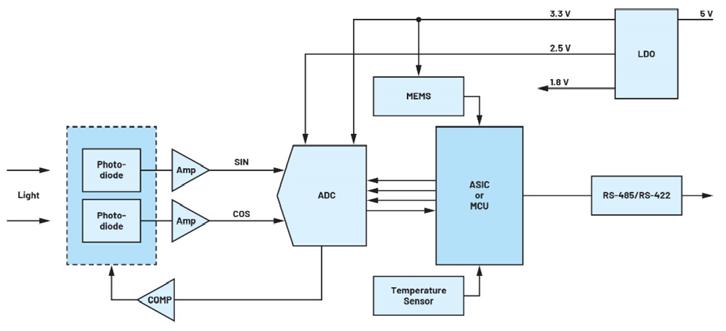
For robots and cobots, motor encoders and joint encoders typically require 16-bit to 18-bit ADC performance, with the 22-bit ADCs required in some cases. High performance ADCs, with up to 24-bit resolution, are also required for some optical absolute position encoders.
Motor encoder signal chains
Figures 6, 7, 8, and 9 illustrate encoder signal chains for magnetic (anisotropic magnetoresistive (AMR) and Hall technologies), optical, and resolver encoders. The components are grouped into five main categories:
1. Tracking shaft position and speed using magnetic sensors (AMR, Hall)
2. Machine health monitoring: MEMS sensors and temperature sensors
3. Intelligence: Microcontroller with/ without integrated ADC and Resolverto-digital converter (RDC)
4. Cable interface: High speed RS-485/ RS-422 transceiver and SPI to RS-485 extender transceiver
5. Signal conditioning: High performance ADCs (12-bit to 24-bit resolution)
Magnetic encoder (AMR) sensing
In the field of magnetic-based position sensors, AMR sensors provide the best combination of robustness and accuracy. The sensor is typically positioned opposite a dipole magnet attached to the motor shaft as depicted in Figure 6.
AMR sensors are sensitive to magnetic field direction changes, unlike Hall technology that is sensitive to field intensity. The resulting advantage is that the sensor is very tolerant to airgap and mechanical tolerance variation in the system. Also, as there is no operating magnetic field upper limit with
AMR sensors, the sensor is extremely robust to stray magnetic fields when operating with a high magnetic field.
The ADA4571 is an AMR sensor with low latency integrated signal conditioning and provides a single-ended analog output. The ADA4571 single-chip solution provides guaranteed angular accuracy (only 0.10 typical angular error) and can operate at speeds up to 50k rpm. The ADA4571-2 is a dual version that provides full redundancy without compromising performance in applications that are safety critical.
The ADA4570 is a derivative of the AAD4571 with the same performance but with a differential output for use in harsher environments. The high angular accuracy and repeatability provided by the ADA457x family improve closed-loop control, reducing motor torque ripple and noise. The singlechip architecture improves reliability, reduces size and weight, and is easier to integrate compared to competing technologies.
Signal Conditioning and Power
The AD7380 4 MSPS dual simultaneous sampling, 16-bit SAR ADC provides many system-level benefits, including a spacesaving 3 mm × 3 mm package important for space-constrained encoder PCB boards. The 4 MSPS throughput rate ensures that detailed sine and cosine cycles are captured, and encoder positions are up to date. The high throughput rate enables oversampling on-chip, which reduces the time penalty of digital ASICs or microcontrollers feeding the precise encoder position to the motor.
An extra benefit of the AD7380’s on-chip oversampling is that it allows for an additional 2 bits of resolution, which can be easily used with an on-chip resolution boost feature. Application note AN-20033
details this oversampling and resolution boost feature of the AD7380. The VCC and VDRIVE of the ADC and the supply rails of the amplifier driver can be powered by an LDO regulator, such as the LT3023. Multiple output low noise LDOs such as the ADP320, LT3023, and LT3029 can be used to power all components in the signal chain.
Transceiver
The ADM3066E RS-485 transceiver features ultralow transmitter and receiver skew performance, which makes these devices ideal for transmission of a precision clock, which is often featured in motor encoding standards, such as EnDat 2.2.4 The ADM3065E has been demonstrated to show less than 5% deterministic jitter across typical cable lengths encountered in motor control applications.
The wide supply range of the ADM3065E means this level of timing performance is available for applications that require either a 3.3 V or 5 V transceiver power supply. For more information, see the technical article “Going Faster and Further with Fieldbus.”
Microcontroller
For applications that require lower resolutions of 12 bits or less, an alternative to using an AD7380 ADC is a microcontroller with integrated ADC. The tiny MAX32672 ultra low power Arm® Cortex®-M4F microcontroller includes a 12-bit 1 MSPS ADC with enhanced security, peripherals, and power management interfaces.
Asset health monitoring
The ADXL371 is an ultralow power, 3-axis, digital output, ±200 g microelectromechanical system (MEMS) accelerometer for machine monitoring. The ADXL371 is cost-effective,
Figure 9. Optical encoder signal chain.

available in a small 3 mm × 3 mm package, and operates at up to +105°C. In instant on mode, the ADXL371 consumes 1.7 μA while continuously monitoring the environment for impacts. When an impact event that exceeds the internally set threshold is detected, the device switches to normal operating mode fast enough to record the event.
The ADT7320 is a high accuracy digital temperature sensor, which requires no user calibration or correction and excellent long-term stability and reliability. The ADT7320 is rated for operation over an extended range of −40°C to +150°C and is available in a small 4 mm × 4 mm LFCSP package.
Magnetic encoder (Hall)
A Hall encoder can be designed using the AD22151 or the AD22151G. The AD22151G is a linear magnetic field transducer. The sensor output is a voltage proportional to a magnetic field applied perpendicularly to the package top surface. To design the encoder system, equally spaced magnets are placed on a rotating motor shaft. As the rotating shaft magnets pass the Hall sensors, the voltage output from the sensor peaks. Using more magnets or sensors produces more resolution. The Hall effect encoder can use the MAX32672 and ADM3066E for the wired interface. The ADXL371 MEMS and ADT7320 offer condition monitoring for harsh encoder environments. The Magnetic Encoder (AMR)
section provides more information on these signal chain components.
Optical encoder
The optical encoder signal chain components are almost identical to those described in the Magnetic Encoder (AMR) section. However, to support higher encoder resolutions, the AD7760 2.5 MSPS, 24-bit, 100 dB sigmadelta (Σ-Δ) ADC is recommended. It combines wide input bandwidth and high speed with the benefits of sigma-delta conversion to achieve a performance of 100 dB SNR at 2.5 MSPS, making it ideal for high speed data acquisition.
Resolver (Coupled) encoder
A resolver encoder has some advantages, such as high mechanical reliability and accuracy; however, compared to a magnet and ADA4571, a resolver is expensive.
The AD2S1200 converts the signal from the resolver to the digital angle/angular rate. Figure 10 shows the resolver signal chain. Two amplifiers are used to create a thirdorder Butterworth low-pass filter to pass the resolver signals to the AD2S1200. Refer to Circuit Note CN0276 for more information.
To save space and reduce design complexity, the LTC4332 SPI extender is recommended. The LTC4332 enables system partitioning, providing the option of placing the microcontroller at the servo, rather than at the encoder. If a microcontroller
is required at the encoder, the MAX32672 SPI interface can be used as the direct link to the AD2S1200 and the ADM3065E RS-485 transceiver can be used instead of the LTC4332.
If the LTC4332 is used, the AD2S1200 SPI output is converted to a robust differential fieldbus interface. The LTC4332 includes three subordinate select lines, so additional sensors such as MEMS and temperature sensors can be wired on the same bus as the AD2S1200.
Conclusion
Analog Devices’ deep domain expertise and advanced technologies help partners design the industrial motor encoders and networks of the future. Integrating asset health insights in encoders is made easy with tiny and powerful microcontrollers, ADXL371 MEMS, and ADT7320 temperature sensors. ADI’s industry-leading AMR magnetic sensors, such as the ADA4571, improve reliability, reduce size and weight, and are easier to integrate into an encoder compared to optical or resolver sensing solutions. High accuracy and repeatability for pick and place machines and robots are possible with mid to high end ADCs such as the AD7380 or AD7760.
Richard Anslow, Senior Manager, Systems Engineering, Analog Devices.
Learn More
Figure 10. Resolver encoder signal chain.
Industrial Ethernet Book
The only publication worldwide dedicated to Industrial Ethernet Networking and the IIoT. Visit iebmedia.com for latest updates.

New website offers deepest, richest archive of Industrial Ethernet and IIoT content on the web.




View and/or download latest issue of Industrial Ethernet Book and past issues.
Search our database for in-depth technical articles on industrial networking.
Learn what's trending from 5G and TSN, to Single Pair Ethernet and more.
Keep up-to-date with new product introductions and industry news.
Revolutionizing precision machining robotics
New machining robotics innovations are bringing a series of enhancements for manufacturers including redefined precision (up to 300 percent better path accuracy for demanding manufacturing processes) and increased productivity and flexibility (increases of up to 40 percent and new application areas).
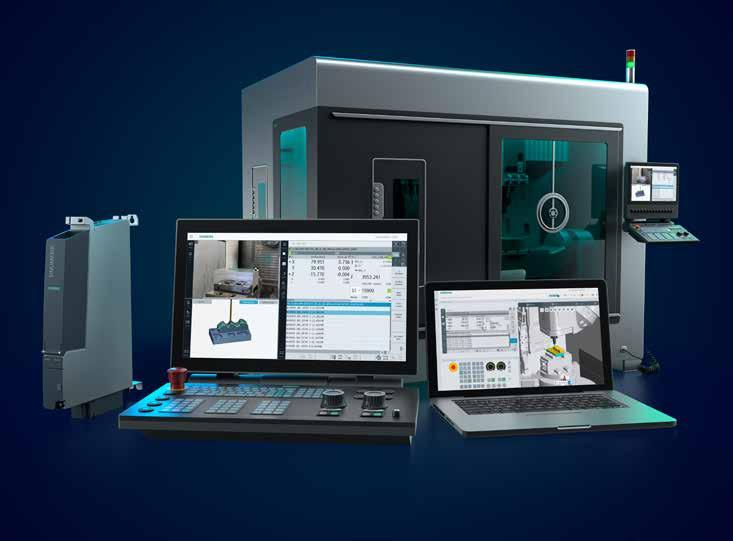
SIEMENS CLAIMS IT IS REVOLUTIONIZING machining robotics with Danobat and autonox by introducing the new Sinumerik Machine Tool Robot.
This innovation brings a series of enhancements for manufacturers:
• Redefining precision: The Siemens Sinumerik Machine Tool Robot offers up to 300 percent better path accuracy for demanding manufacturing processes
• Increased productivity and flexibility: Innovative control concepts enable productivity increases of up to 40 percent, and reveal new application areas
• Strong partnerships: autonox and Danobat are the first partners to integrate the Sinumerik Machine Tool Robot into their high-precision robotic solutions
Siemens states that this groundbreaking technology is a significant advance in the precision and productivity of robots that will open the door to new applications in the manufacturing industry.
The Sinumerik Machine Tool Robot from Siemens is expanding the already successful Sinumerik Run MyRobot /Direct Control solution with new functions and robot types.
The Sinumerik MTR enables a quantum leap in accuracy and productivity across the entire
workspace. MTR is based on an intelligent control concept that gives industrial robots the characteristics of machine tools. This supports high-precision path applications, even when machining hard materials like steel, whose toughness calls for increased cutting forces and more damping. Compared to conventional industrial robots, the Sinumerik MTR overcomes these challenges with a 200 to 300 percent increase in path accuracy and significantly higher dynamic rigidity.
These characteristics make the Sinumerik MTR designed for industries like aerospace, defense, and automotive and many other high-precision robotic applications,
The Sinumerik Machine Tool Robot is controlled by Sinumerik One, the digital native CNC from Siemens.
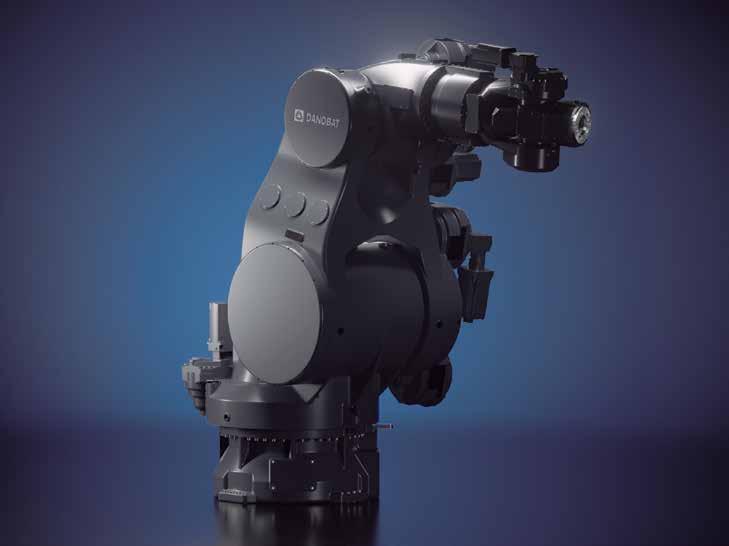
including post-processing of 3D-printed metal parts. In addition to improved accuracy, the new control concept brings a 20 to 40 percent productivity increase. This makes the Sinumerik MTR especially attractive for applications that don’t employ process forces, including waterjet and laser cutting. The Sinumerik MTR is controlled by Sinumerik One, the digital native CNC from Siemens. Thanks to its digital twin, it is the key element in digital transformation and helps to simulate and test workflows in a completely virtual environment. Sinumerik One is part of Siemens Xcelerator, the open, digital business platform from Siemens.
Automation partners
The first partners to integrate the MTR into their robots are autonox and Danobat. autonox Robotics: A proven partner for innovative solutions, autonox Robotics is a long-standing partner in the Sinumerik Run MyRobot ecosystem. The company is known for its powerful and reliable robotic solutions that are used in numerous industries worldwide. autonox offers its customers more
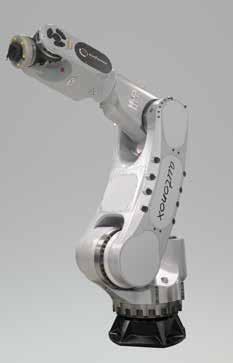
accurate and efficient machining solutions using dedicated CNC robotic mechanisms.
Danobat: A new player in the highprecision CNC robotics market. Danobat is an internationally active consortium and a new Siemens partner. It offers MTR robots ranging from a compact version with a payload capacity up to 220 kg and a 2.6 m reach to the most robust model that can handle a payload up to 520 kg with a 3.6 m reach.
These robots combine the accuracy and stability of a machine tool with the agility and flexibility of a 6-axis robot, which creates new manufacturing opportunities for demanding industries like aerospace, e-mobility, and energy. Thanks to its partnership with Siemens and the integration of the Sinumerik MTR, Danobat can continue strengthening its position as one of the leading providers of high-precision robotic solutions and tap into new market segments.
Technology article by Siemens.
Learn More
Thanks to its partnership with Siemens and the integration of the Sinumerik MTR, Danobat can continue strengthening its position as one of the leading providers of high- precision robotic solutions and tap into new market segments.
SOURCE: SIEMENS
One of the first two partners to integrate the Sinumerik MTR into their robots is autonox.
Powering up the Industrial Internet of Things with PoE
This article explores how Power Over Ethernet (PoE) effectively tackles the power challenges of the IIoT. We will also discuss how PoE is incorporating new intelligent features for more efficient power management and control.
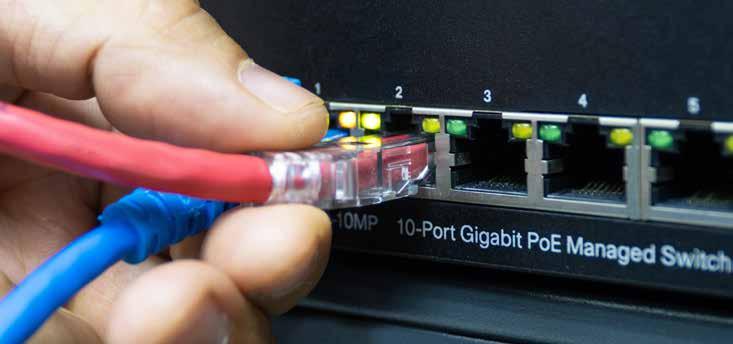
THE INDUSTRIAL INTERNET OF THINGs (IIoT) is increasingly being made possible by Power over Ethernet (PoE). In the past, installing data-gathering devices in industrial settings, especially at the network’s edge, was a complex task due to the need for individual power supplies, intricate wiring, limited mounting options, and extra costs.
By delivering power and data over Ethernet cables, PoE has simplified connectivity for the growing range of PoE-enabled industrial devices, such as IP cameras, smart sensors, and other data collection tools, making build-outs more convenient and cost-effective.
In this article, we explore how PoE effectively tackles the power challenges of the IIoT. We will also discuss how PoE is incorporating new intelligent features for more efficient power management and control.
IIoT: the future of manufacturing
The transformative application of IoT technology in industrial processes and applications is known as the IIoT. Connection of machinery, network devices, smart sensors, and software, the IIoT gathers, enables the exchange and analysis of data at every stage of the production process. As a result, seemingly unrelated information
becomes valuable insights that can be acted upon, inspiring a new era of productivity. By enhancing visibility, the IIoT also helps businesses identify potential inefficiencies –such as underperforming machinery, excessive power consumption, or processes causing bottlenecks – to reduce downtime. Examples of the IIoT in action include automation, predictive maintenance, quality assurance, smart logistics, and product development, among countless others.
PoE is an IIoT game-changer
The evolution of PoE standards from 802.3af (PoE) and 802.3at (PoE+) to the latest ultra-high power 802.3bt (PoE++) is a testament to the technology’s adaptability and future potential. With maximum power support of 90 watts, PoE now applies to a broader range of industrial verticals, bringing the following benefits:
PoE can slash overall installation costs by up to 50 percent by eliminating the need for separate electrical wiring, conduit, safety equipment, and power outlets. This also expands options for how and where end-devices can be mounted.
PoE systems offer stability since they adhere to the strict regulations of the IEEE for more
reliable network connections and smoother operation. These standards also incorporate mechanisms that ensure compatibility between devices and protect those devices that do not support PoE.
PoE improves employee safety by eliminating the requirement for high-voltage power cables. PoE operates at a lower voltage, typically 48VDC, which is considered safe for handling. Conversely, 120VAC is 2.4 times higher than 48VDC, plus AC is generally considered more dangerous because its alternating current can disrupt the electrical signals in the human body, especially the heart.
PoE opens up new opportunities for scalability. PoE-enabled IIoT devices can be installed in remote areas without available local power or easily relocated up to 100 meters from power-sourcing equipment. Cable length can also be extended beyond 100 meters using a repeater or another industrial PoE switch.
PoE allows for centralized power management.
PoE improved the continuity of power delivery by offering backup power options.
Another plus for PoE is that its power can be automatically shut off or reduced for non-essential devices when they are not in
The Sinumerik Machine Tool Robot is controlled by Sinumerik One, the digital native CNC from Siemens.
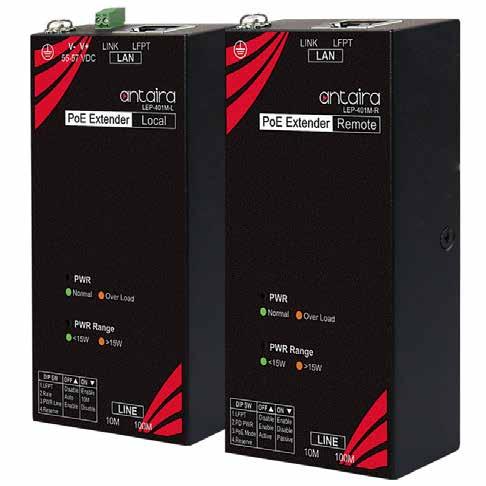
use. If the power budget is overdrawn, PoE switch ports can be configured to receive power from higher-priority devices. All these advantages make PoE a game-changer for IIoT.
Power delivery process
Power Sourcing Equipment (PSE), which can be either an industrial switch, router, or other network device that supports PoE, provides DC power over an Ethernet cable to Powered Devices (PDs). Typically, the power supply is 48V-55V DC, although some devices may support higher or lower voltages depending on their specific needs.
Ethernet cables are the backbone of PoE technology. These cables contain four twisted pairs of copper wires, which are used to carry both the data signals and the DC power required by powered devices. To ensure reliable and efficient transmission, the Ethernet cable must be Category 5e (Cat 5e) or higher. However, note that using Cat5e to power Class 3 or Class 4 PD devices may cause them to overheat. Cat 6A is therefore recommended, especially for longer distances. Proper connectivity is also crucial; the Ethernet cable must be securely connected to both the PSE and the PD to maintain a stable and reliable connection.
Standard Configurations Simplify Installation
The 802.3af, 802.3at, and 802.3bt standards of the Institute of Electrical and Electronics
Engineers (IEEE) regulate PoE. These standards outline the requirements for both the PSE and the PD, including the maximum amount of power that can be supplied and the signaling mechanisms used to negotiate power requirements. Typically, the configuration process involves setting up the PSE to supply power to the PD, with the PD communicating its power needs to the PSE through a standardized protocol, also known as the handshake. This negotiation process is usually automated, ensuring that the PD receives the appropriate amount of power without manual intervention. Adhering to these standards ensures compatibility across different PoE devices.
Availability and redundancy
High availability and redundancy are essential in industrial applications to minimize downtime and achieve continuous operation. PoE technology addresses these needs by allowing for redundant power supplies and dual power input configurations. Redundancy helps the device remains operational even in the event of a power source failure. Redundant power supplies enable a device to continue operating even if one power supply fails, while dual power input allows the device to be powered from two separate power sources. By incorporating these features,
SOURCE: ANTAIRA
PoE enhances the reliability and resilience of networked systems, making it a robust solution for critical industrial applications.
Smarter PoE switches for the IIoT Antaira PoE Ethernet switches adhere to IEEE standards, serving as foundational PSEs for IIoT networks. Beyond compliance, Antaira industrial PoE switches incorporate patented technologies that add intelligence to networks. Let’s explore how these innovative features work
Safe PoE Disconnect: To meet the rising number of high-power PoE cameras, wireless and LIDAR installed in various applications, Antaira developed the patented Safe PoE Disconnect technology supported by unmanaged IEEE 802.3bt industrial ethernet switches. Safe PoE Disconnect is a hardware safety feature that lets engineers easily turn on/off power to a single 802.3vt PoE++ port using a front panel DIP switch. Turning off the DIP Switch allows the end device to be safely discovered.
Persistent PoE: During a switch firmware update, persistent PoE enables an Antaira industrial switch to reboot while continuing to provide PoE power to a connected PD. It keeps connected devices powered on to avoid the end device reboot, which otherwise can result in several minutes of device downtime.
Power Remote Reset Technology (PRRT): Available on Antaira LNP-C501G-SFP-bt-T and IMP-C1000-SFP-bt-T series products, PRRT allows a user to reset a PD at a remote site without physically visiting the location, helping to save on travel costs and minimizing powered device downtime.
iPoE Budget Control: To protect connected devices in applications where input voltage varies, Antaira has designed an automatic mechanism -- “Intelligent PoE” or “iPoE” for short -- with patents in the USA and Taiwan. This technology further confirms the power input voltage of the PSE before determining the safe maximum power output budget to allocate to the PD. For example, when 12VDC is powering the industrial switch, the switch auto-senses the voltage input and limits the PoE power budget to 90 Watts. In contrast, if the voltage input increases to 24VDC, it would increase the PoE power budget up to 150 Watts.
Low-Voltage PoE: Although not a patented technology, Antaira low-voltage PoE opens up new opportunities in network design. Adding an internal DC-to-DC power boost to select models allows low-voltage PoE to power up to 90W bt PoE++ from a low-voltage input, such as 9VDC, 12VDC, 24VDC, or 36VDC.
Henry Martel, Application Field Engineer, Antaira Technologies.
Learn More
Antaira offers an extensive range of PoE solutions, including managed and unmanaged Ethernet switches in IEEE PoE at/af/bt standards, alongside PoE injectors and media converters.
Cloud collaboration & AI Copilot power machine control projects
Use of Automation Studio Code and Copilot can boost productivity and enhance teamwork in software development for industrial automation. Cloud collaboration simplifies teamwork across devices and locations, and creates effective environment for developing industrial automation factory applications.

A NEW CODING ENVIRONMENT WITH CLOUD collaboration tools and AI assistant combines Automation Studio Code and Copilot to boost productivity and enhance teamwork in software development for industrial automation. Features include:
• New coding environment delivers modern experience and advanced editing for faster development
• AI-assisted code generation and optimization accelerate time-tomarket and boost code quality
• Cloud collaboration simplifies teamwork across devices and locations
At the most recent SPS exhibition in Nuremberg, Germany, B&R announced a major update to its comprehensive suite of engineering and runtime software. With Automation Studio Code, B&R introduces an entirely new engineering experience. It incorporates an array of advanced editing
functions, drawing from the latest the software industry has to offer. With flexible local or cloud-based access, it supports seamless collaborative engineering. Fully integrated in this new environment is Automation Studio Copilot, a generative AI coding assistant developed in cooperation with Microsoft. Among the numerous upgrades in the new release, these standout additions promise a dramatic impact on the software development experience for machine builders and system integrators.
Elevating the engineering experience in machine automation
"Bringing state-of-the-art software engineering into the world of machine automation is crucial to helping our customers stay a step ahead of rapid changes in today's markets," said B&R Chief Technology Officer Florian Schneeberger.
"With a productivity boost from modern development tools and generative AI, together with the flexibility of cloud collaboration, we help them develop faster with more agile teamwork and get innovative machines to market fast."
In Version 6 of B&R's engineering software, Automation Studio Code adds powerful new engineering capabilities, while offering full flexibility to open the same projects in either the new environment or the familiar Automation Studio interface. Among the new capabilities are rich syntax highlighting, which makes code easier to read, and objectoriented programming in Structured Text, which helps engineers organize their code more logically and work more efficiently. Real-time error detection eliminates repetitive compiling and correction loops, and the ability to adapt the theme to dark mode helps prevent developer fatigue.
The new version of B&R's automation software delivers advanced engineering capabilities, enhanced collaboration and an AI productivity boost

"Bringing state-of-the-art software engineering into the world of machine automation is crucial to helping our customers stay a step ahead of rapid changes in today's markets," -- Florian Schneeberger, Chief Technology Officer, B&R.
Productivity boost with generative AI
One of the most significant contributions to accelerated machine development comes in the form of Automation Studio Copilot, the AI companion embedded in the new coding environment. Copilot allows developers to generate executable machine code simply by entering prompts in natural language. It also helps optimize and annotate existing code, making it easier to share and reuse. Complex applications can be quickly summarized to facilitate discussions with non-technical stakeholders.
Describing what typical project workflow might look like, Software Strategy Manager Manuel Sanchez-Marchan says: "You might start by setting up a project in the familiar, feature-rich Automation Studio environment. Then you can jump over to Automation Studio Code to develop your application and share it with your team, using all the modern editing features and enjoying all the advantages of cloud collaboration and seamless source control. Every step of the way, you have Automation Studio Copilot at your side – whether you get stuck on a tricky problem or just want a faster way to get things done."
Seamless flexibility
Automation Studio Code offers a seamless experience for developers, whether they
choose to open projects on their desktop or in a web browser. "It's a lot like the tools we all use to collaborate on documents, spreadsheets and presentations," explains Sanchez-Marchan.
"Considering how dramatically those tools have transformed office work, it's easy to imagine what it means to bring the same level of collaboration to software development processes in the automation industry."
With teams collaborating in real-time from different locations, topics like source control become more important than ever. "B&R has always been a step ahead with easy source control thanks to the file-based nature of Automation Studio projects," said Sanchez-Marchan.
"With Automation Studio Code, we're now taking that a step further. By building source control tasks right into the development environment, we remove distractions and allow developers to focus on their creative work," he added.
Connection of git repositories enables integration of third-party tools like GitHub or Azure DevOps. These version control and collaboration tools make it easy to merge contributions from different team members, keep track of changes, and ensure that everyone is always working from the latest version of the software to provide the most efficient coding environment.
Streamlined development with cloud-based engineering
A cloud-based engineering solution eliminates the need to install the development environment locally. This prevents challenges in version management and dependencies from becoming bottlenecks for team efficiency. Development teams frequently face long hardware lifecycles and multiple tool versions across different machines, adding complexity to their processes.
Moreover, IT restrictions on local software management can further hinder productivity, requiring virtual machines or specialized development setups to support different versions of the environment. Cloud-based engineering eliminates these obstacles, streamlining setup and maintenance.
With a project dashboard offering a clear overview of their projects all in one place, engineers can easily see what is in progress and what needs attention. "You spend less time searching for files or trying to remember where you left off, and more time actually developing and refining your code," says Sanchez-Marchan. Projects can be shared by sending a link – which a teammate or client can open directly in their browser without needing to install any additional software.
Article by B&R.
Visit Website
The value of the IIoT and connected applications
The integration of IIoT and connected applications is revolutionizing the manufacturing industry. By leveraging real-time data, predictive analytics, and advanced automation, manufacturers can optimize their operations, improve product quality, and enhance supply chain visibility.

The future of manufacturing is connected, intelligent, and remarkably efficient. Embracing IIoT is not just a technological advancement; it’s a strategic imperative for achieving long-term competitiveness and success.
REAL-TIME DATA COLLECTION AND ANALYSIS are at the heart of the Industrial Internt of Things (IIoT). By continuously monitoring equipment and production processes, manufacturers can detect anomalies, predict equipment failures, and take corrective actions before issues escalate.In today’s dynamic manufacturing landscape, efficiency is the cornerstone of competitiveness.
The Industrial Internet of Things (IIoT) and connected applications offer transformative solutions to streamline shop floor operations, enhance productivity, and achieve significant cost savings. By leveraging real-time data and advanced analytics, manufacturers can optimize processes and make informed decisions that drive operational excellence.
Understanding IIoT in manufacturing
The Industrial Internet of Things (IIoT) involves connecting physical industrial assets—such as machinery and equipment— to the Internet, allowing for real-time data exchange and analytics. According to Gartner, this integration provides manufacturers with unprecedented visibility into their operations, enabling predictive maintenance, quality control, and enhanced operational efficiency specifically tailored to industrial environments.
Real-time data: the heart of IIoT
Real-time data collection and analysis are at the heart of IIoT. By continuously monitoring equipment and production processes, manufacturers can detect anomalies, predict equipment failures, and take corrective actions
before issues escalate. Gartner reports that real-time data insights can lead to significant improvements in visibility and control across shop floors, reducing downtime and extending machinery life.
For instance, a prominent automotive parts manufacturer implemented an IIoT-based predictive maintenance system. This system monitored critical parameters such as vibration, temperature, and pressure, enabling the company to predict and address potential failures before they occurred. According to Gartner, they reduced unplanned downtime by 30% and extended the operational life of their equipment by 15%.
Enhancing operational efficiency
IIoT enables the automation of various manufacturing processes, reducing human
error and increasing production speed and accuracy. By optimizing resource use through the use of sustainability, IIoT helps manufacturers reduce waste and operational costs. Additionally, improved visibility across the supply chain enhances coordination and efficiency. According to Gartner, this ensures that production schedules are met and customer demands are fulfilled.
A case in point is a consumer electronics manufacturer that integrated IIoT solutions to monitor and optimize its production line. Gartner noted that by analyzing real-time data, the company was able to identify bottlenecks and streamline operations, resulting in a 20% increase in production efficiency and a 10% reduction in material waste according to Gartner’s Hype Cycle for Advanced Technologies for Manufacturers, 2023.
Predictive maintenance and asset management
Traditional maintenance strategies, often based on fixed schedules, can lead to unnecessary downtime or unexpected failures. IIoT facilitates predictive maintenance by continuously monitoring equipment conditions and performance. Sensors detect anomalies such as unusual vibrations or temperature changes, indicating potential issues before they lead to failures. Gartner’s research highlights that this proactive approach not only prolongs machinery life but also reduces maintenance costs and unplanned downtime.
For example, a large-scale food processing company utilized IIoT sensors to monitor the condition of its refrigeration units. By analyzing the data, Gartner reports they were able to predict failures and schedule maintenance activities more effectively, resulting in a 25% reduction in maintenance costs and a 35% decrease in unplanned downtime based on their latest Digital Twins research.
Quality control and improvement
Maintaining high product quality is essential for any manufacturer. IIoT provides tools to enhance quality control by integrating real-time monitoring systems with either with MOM/MES and Enterprise Resource Planning (ERP) systems. This integration helps track production quality at every stage, identifying defects early in the process and reducing reject rates. For instance, a medical device manufacturer reduced its reject rates from 30% to 2% by implementing a real-time monitoring system integrated with their ERP system, as noted by Gartner in their recent report, Strategic Insights Leveraging IIOT & Connected Applications in Manufacturing.
Supply chain optimization
IIoT extends beyond the shop floor to the entire supply chain, providing end-to-end
visibility. This visibility helps in tracking raw materials, work-in-progress, and finished goods in real time, reducing the need for buffer stock and improving order fulfillment accuracy. Combining IIoT with technologies like blockchain can further enhance supply chain transparency. According to Gartner, this ensures product authenticity and reduces the risk of counterfeiting.
For example, a global pharmaceutical company used IIoT to track the movement of raw materials and finished products throughout its supply chain. Gartner reports that by integrating blockchain technology, they ensured the authenticity of their products and reduced the risk of counterfeiting, thereby increasing customer trust and regulatory compliance.
Driving efficiency gains with manufacturing
Manufacturing Operations Management (MOM) and Manufacturing Execution Systems (MES) are pivotal in driving efficiency gains in modern manufacturing. MOM encompasses all activities related to managing manufacturing operations, while MES specifically focuses on the execution and real-time monitoring of production processes.
Manufacturing Execution Systems (MES) focus on the execution of manufacturing processes on the shop floor. MES provides real-time visibility into production activities, helping manufacturers track work-in-progress, monitor equipment status, and ensure compliance with production schedules. By capturing real-time data on production performance, MES enables manufacturers to identify and address bottlenecks, optimize production schedules, and improve product quality.
Manufacturing Operations Management (MOM) provides a comprehensive approach to managing all aspects of manufacturing operations. MOM encompasses MES functions but also is extended to control quality control, maintenance, and inventory management ensuring seamless communication and coordination across all areas of the manufacturing process.
For example, a leading metal forming company integrated MES into their existing MOM system to enhance shop floor operations. DELMIAWorks reports that the MES solution provided real-time monitoring of machine performance, allowing the company to track production cycles, identify deviations from standard operating parameters, and take corrective actions promptly, resulting in a 20% increase in throughput, and a 15% reduction in scrap rates.
The integration of MES and MOM systems also facilitates predictive maintenance. By continuously monitoring equipment conditions and performance, manufacturers can predict
when maintenance is needed and schedule it accordingly, minimizing unplanned downtime and extending equipment life.
Overcoming challenges in IIoT implementation
Implementing IIoT systems comes with challenges, such as integration with existing infrastructure, data management, and cybersecurity concerns. Manufacturers should adopt scalable IIoT platforms that support diverse protocols and standards. Edge computing can help manage and analyze data locally, reducing latency and bandwidth usage. Ensuring robust cybersecurity measures and technologies, such as strong authentication and encryption, is critical to protect sensitive data. Gartner highlights these considerations in their report on the benefits of IIoT for small to midsize manufacturers.
A successful implementation strategy involves starting small with pilot projects and scaling up as the organization gains more experience and confidence. Gartner suggests it’s also essential to ensure that all stakeholders are on board and understand the benefits and challenges of IIoT.
Future trends: artificial intelligence and digital twins
The future of IIoT in manufacturing will be shaped by advancements in artificial intelligence (AI) and digital twins. Digital twins, which are digital replicas of physical assets, enable real-time monitoring, simulation, and optimization of manufacturing processes. Integrating AI with IIoT systems will provide deeper insights and predictive capabilities, further enhancing efficiency and productivity. According to Gartner, the market for simulation digital twins is expected to reach $379 billion by 2034, highlighting their growing importance in the industrial sector.
The integration of IIoT and connected applications is revolutionizing the manufacturing industry. By leveraging real-time data, predictive analytics, and advanced automation, manufacturers can optimize their operations, improve product quality, and enhance supply chain visibility. As the industry continues to evolve, those who embrace IIoT will be well positioned to lead in the era of smart manufacturing, driving innovation and excellence in their operations.
The future of manufacturing is connected, intelligent, and remarkably efficient. Embracing IIoT is not just a technological advancement; it’s a strategic imperative for achieving long-term competitiveness and success.
Louis Columbus, Senior Industry Marketing Manager, DELMIA.
Industrial-grade private 5G
Siemens scales up private 5G infrastructure with expanded coverage and availability in more countries. New compact 5G router, part of Xcelerator portfolio, launched for cabinet use.
SOURCE: SIEMENS
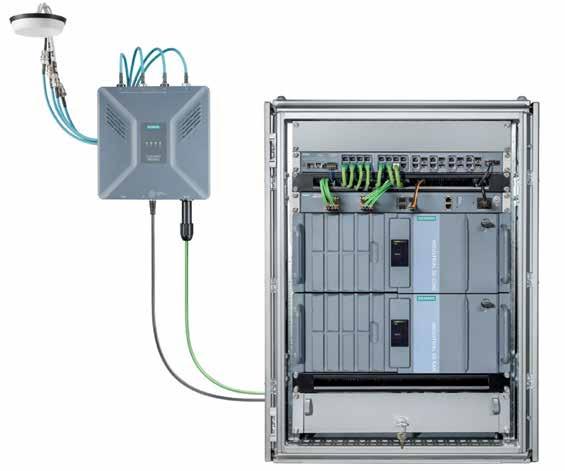
smart sensors and edge devices, enabling data-driven decisions on the shop floor through artificial intelligence applications.
User-friendly design
meets industrial requirements
Building on these capabilities, Siemens has developed this solution specifically for industrial use cases and requirements. The system features an innovative, userfriendly approach with a straightforward configuration process that only requires about 20 variables in a single comprehensive Web user interface.
A clearly arranged dashboard offers a comprehensive overview of the network status making it accessible even for non-IT users. While many industry solutions require specialized expertise, Siemens' approach prioritizes userfriendly operation and simple implementation to support mission- and business-critical applications.
Siemens has announced a significant update to its industrial- grade private 5G infrastructure solution, that will enable manufacturers to cover larger industrial areas with enhanced connectivity capabilities. The expanded solution now supports up to 24 radio units, with each unit capable of covering approximately 5,000 m².
The updated private 5G infrastructure is now available in multiple countries including Germany, Sweden, Netherlands, Switzerland, Denmark, Austria, and Brazil, and there are plans to expand to additional countries throughout 2025. When the initial version of Siemens’ private 5G infrastructure was launched in 2023, it was exclusively available in Germany.
To complement the infrastructure expansion, Siemens is also introducing the new compact Scalance MUB852-1, an entry-level 5G router for cabinet use with IP20 protection class, part of the Siemens Xcelerator portfolio. The router matches the Siemens Simatic ET200 I/O footprint and
integrates seamlessly into Siemens’ Totally Integrated Automation (TIA) landscape.
"Our enhanced private 5G infrastructure solution represents another milestone in connected production," said Axel Lorenz, CEO of Process Automation at Siemens.
"By enabling coverage of larger industrial areas while maintaining the same reliable connectivity, we're meeting the growing demands of modern manufacturing environments."
The enhanced solution comes at a crucial time, when reliable wireless connectivity in factory environments is facing increasing challenges. The traditional unlicensed Wi-Fi spectrum often becomes overloaded in crowded settings, leading to communication outages and potential production shutdowns.
Siemens' private 5G infrastructure directly addresses these challenges by providing a dedicated, network solution for missioncritical applications. Private 5G networks also create the flexible communication infrastructure needed to easily integrate
This private 5G infrastructure will be extremely valuable across a variety of industrial sectors, including manufacturing, food and beverage, pharmaceuticals, intralogistics, heavy industries, and mining. The system allows companies to operate their networks independently without relying on thirdparty providers, which ensures enhanced cybersecurity and data privacy thanks to on-site installation.
Users can flexibly modify their networks to meet changing demands and perform fast troubleshooting when necessary.
"The industrial world is moving away from the 'one-size-fits-all' approach to wireless connectivity. With our private industrial 5G infrastructure, we're giving manufacturers the tools to design their digital backbone exactly the way they need to, whether they're running a single production line or an entire smart factory complex,” Lorenz said.
Siemens
Private industrial 5G infrastructure solution now supports up to 24 radio units.
TwinCAT Core Boost & hybrid connectors
TwinCAT Core Boost Accelerates IPC Performance for Next-Level Automation. Expansion of hybrid connector portfolio is ready for upcoming IEC 61076-2-118 standard updates.
TwinCAT Core Boost
A new ‘turbo mode’ from Beckhoff enables an up to 50% leap in system performance, increasing flexibility and, in some cases, lowering controller costs
With TwinCAT Core Boost, Beckhoff is supercharging its proven TwinCAT 3 runtime and robust multicore processing power with turbo mode. TwinCAT Core Boost increases the computing performance of individual real-time or user-mode cores by up to 50%. Now, systems can achieve maximum performance, adapt to unique application requirements, and possibly use lower cost CPUs while tapping into extra performance for specific tasks as needed.
TwinCAT software’s multi-thread capabilities have long enabled applications to be distributed across multiple cores. TwinCAT Core Boost takes that to the next level by enabling users to configure the clock frequency of individual processor cores. The clock rate per core can be defined for real-time transmission and user-mode applications. Individual cores can operate permanently and in real-time using this “turbo mode.”
TwinCAT Core Boost monitors the permitted power consumption and temperature of each processor core (and of the overall system) to ensure reliable operation even when turbo mode is used. TwinCAT Core Boost currently supports all Beckhoff Industrial PCs with Intel Core I processors from the 11th generation onwards.
Hybrid Connectors in Industrial Cable Offering
A comprehensive hybrid connector portfolio from Beckhoff is ready for upcoming IEC 61076-2-118 standard updates, further enhancing EtherCAT-based One Cable Automation technology.
Beckhoff’s hybrid connectors, part of the company’s One Cable Automation (OCA) solution, are receiving a major update to better support distributed automation well into the future. Beyond the design advantages of consistent modularization with a uniform data core, these connectors now comply with the upcoming IEC 61076-2-118 standard, enabling a seamless transition in advance of the rollout.
Roughly 100,000 OCA connectors from Beckhoff have already been proven in the field, predominantly in EtherCAT applications. Now, Beckhoff hybrid connectors are among the first products to comply with the IEC 610762-118 standard, which should be published by the end of 2024. Early adoption of this standard safeguards users in two key ways:

With TwinCAT Core Boost, individual processor cores in Beckhoff controllers can offer 50% higher performance when in turbo mode.
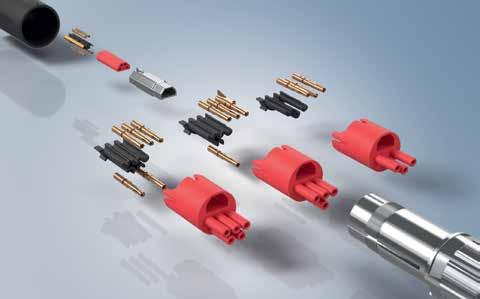
Already compliant with the upcoming IEC 61076-2-118 standard, modular hybrid connectors from Beckhoff will continue to simplify cable assembly and installation.
• strengthening supply chains and secondsource strategies to ensure availability
• maximizing long-term reliability through established and widely adopted standards
Hybrid connectors transmit power and data via a single line to reduce cable and connector expense, not to mention assembly time and cost.
The OCA solution, which Beckhoff developed with a partner, offers the additional advantage of high modularity, permitting a
wide range of cable and connector variants for numerous applications while providing mechanical coding to minimize connection errors.
The uniform data module remains standard in all four sizes: B12, B17, B23, and B40. This modularity greatly simplifies installation rather than creating additional work.
Beckhoff Automation
Learn More
SOURCE: BECKHOFF
Compact expansion box PC
Compact size meets versatile expansion in the Nuvo-2822 expansion box PC from Impulse Embedded. Easily integrate data acquisition or frame grabber cards, with this cost effective, compact solution.
Impulse Embedded has announced the availability of the Nuvo-2822, a new, compact expansion box PC from Neousys, which offers five times the performance over their previous model using the impressive and power-efficient Intel® Alder Lake N97 CPU that can efficiently process vast amounts of data in real time. That, combined with its four PCIe/PCI expansion slots and affordable price, make it a powerful and versatile PC all in one.
The Nuvo-2822 is designed for real-world applications that need reliability, such as on a factory floor, as part of an IoT system, or in machine automation setups. It features a 4-channel isolated DI, a 4-channel isolated DO, and four COM ports to communicate with and control various industrial sensors, indicators, motors, and actuators.
Key features of the Nuvo-2822 include:
• Intel Alder Lake N97 quad core 2.0Ghz processor Max. TDP 12W
• CE, FCC Class A, ROHS certified
• -10°C to +60°C operating temperature (-10°C to +70°C with fan)
• 12V to 24V DC (Terminal block)
• 1x PCIe in x4 size (supports x4), 1x PCIe in x4 size (supports x1), 2x PCI (33MHz/32bit 5V)
Measuring a mere 164.6mm (W) x 214.6mm (D) x 135.6mm (H), the Nuvo-2822 is perfect for systems with space constraints. It can easily be fitted into a compact control cabinet, mounted within machinery, or tucked away in a tight industrial workspace without affecting accessibility. This small footprint allows it to be integrated into environments where rack computers simply wouldn’t fit.
Aside from its size, this box PC is also made to be durable. The rugged build is designed to handle extreme conditions, with an operating temperature range of -10°C to 60°C or, with the addition of a fan, as high as 70°C. Its Intel® Alder Lake N CPU can process large amounts of data in real time. The Alder Lake N family of CPUs are low-power, costeffective processors designed primarily for embedded systems, IoT, and edge computing using Intel's 12th-generation Alder Lake architecture. Unlike mainstream Alder Lake chips, the N series focuses solely on efficiency cores (E-cores) rather than performance cores (P-cores).
Its wide-range DC input (12V to 24V) further enhances its ability to adapt to different industrial power setups. This flexibility is particularly valuable in industrial automation, transportation, and remote
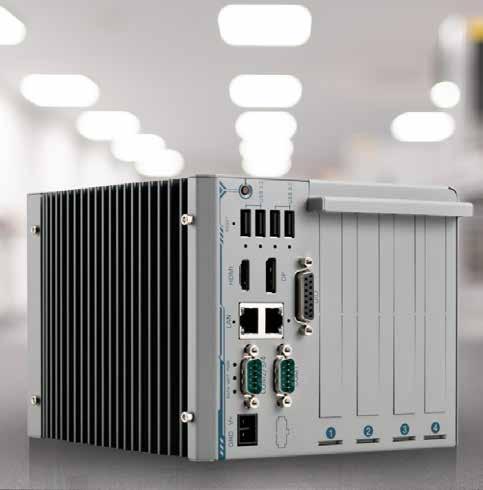
monitoring applications, where power sources can vary.
Despite its small form factor, the device has dual Gigabit Ethernet ports, four USB 3.0 ports, and two COM ports, offering plenty of options for integrating with existing systems. Support for PCIe and PCI expansion cards makes it flexible enough to handle specialised tasks in industrial control or automation, and storage options are versatile, too, with an M.2 SATA SSD slot and a 2.5” drive bay for added capacity.
The Nuvo-2822 introduces a new feature for improved power efficiency: its “Super Power Saving Mode” dramatically reduces energy consumption when the system is in standby (S4/S5) mode. This makes it practical for anyone aiming to optimise energy and improve the sustainability of their operations, not to mention cost savings, without sacrificing functionality.
Thanks to its compatibility with Neousys’ 100 TOPS Intelligent Frame Grabber Card, powered by the NVIDIA Jetson Orin NX, the system can
also be easily upgraded to handle AI inference tasks. This means existing x86-based setups can be transformed into high-performance AI platforms without needing an entirely new infrastructure. By integrating the Intelligent Frame Grabber Card, the Nuvo-2822 can efficiently handle object detection, anomaly detection, and predictive maintenance—all at the edge, reducing latency and reliance on cloud computing.
The Nuvo-2822 offers a high degree of flexibility. It balances performance, efficiency, and adaptability, meaning it can fit naturally into a range of industrial scenarios. Its compact design means it can run easily in tight spaces and contribute to energyconscious operations, and its practicality makes it an all-arounder for industrial systems with modern challenges.
Impulse Embedded
Learn More
Improved power efficiency “Super Power Saving Mode”.
Enhanced IT/OT integration
A new release of the OpreX Collaborative Information Server from Yokogawa strengthens connectivity with a range of devices and applications to support digital transformation.
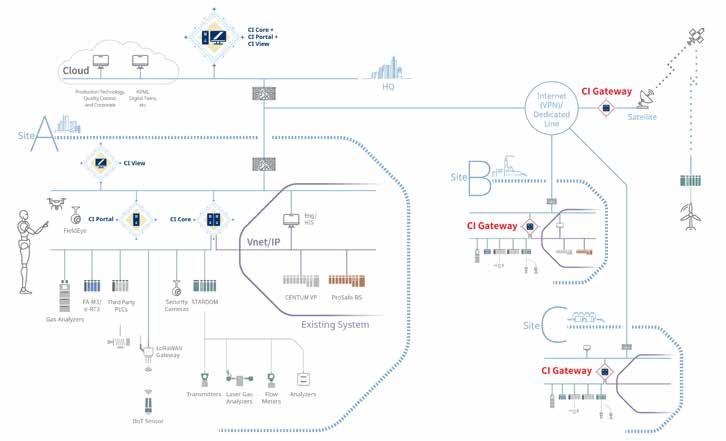
New CI Gateway component allows for simpler and more flexible implementation, making it easier to deploy OpreX Collaborative Information Server as a dedicated gateway.
Yokogawa Electric Corporation announced the release on this date of the latest version of OpreX Collaborative Information Server (CI Server), a product in the OpreX Control and Safety System family, with enhancements that streamline application assembly and improve external connectivity.
OpreX Collaborative Information Server brings together large volumes of data from various plant equipment and systems to enable the optimized management of production activities across an entire enterprise, and provide the environment needed to remotely monitor and manage operations from any location and make swift decisions.
Development background
Plants incorporate a range of equipment and devices, and it is essential to have the capability to swiftly detect and address any abnormalities in operations and utilize the data held by other systems and devices to increase maintenance efficiency. As such, systems need connectivity with other systems and devices, as well as functionality to leverage the information they collect.
Addition of CI Gateway component
At renewable energy facilities and the like, gateways are deployed at various locations for the collection of data required for integrated monitoring and operations. And in all kinds of industries, the use of gateways for the relay of plant data to assemble higher-level applications is a common practice. In this release, a new component, CI Gateway, has been added. Compared to the previous version, this allows for simpler and more flexible implementation, making it easier to deploy OpreX Collaborative Information Server as a dedicated gateway.
Support of RESTful API
The RESTful API is a standard web application interface that is widely used in IT applications. With this release, it is now possible to access OpreX Collaborative Information Server data via the RESTful API. This facilitates access to operational technology (OT) data and leads to closer convergence between IT and OT systems, thereby realizing seamless integration and the efficient use of data. For example, it is now possible to construct a general-purpose web browser-based KPI dashboard that aggregates
and displays data from various systems.
Enhanced IEC 61850 communication driver
IEC61850 is an international protocol for communication networks/systems that is essential in the renewable energy industry. The enhanced support for this standard enables users to select safer interactive operations in place of certain operations that previously were executed automatically. For greater flexibility in operations, it is also now possible to utilize device report data as OpreX Collaborative Information Server data.
Target markets and applications
Oil and gas, petrochemicals, chemicals, renewable energy, power, pulp and paper, pharmaceuticals, food, mining, iron and steel, water distribution, and wastewater treatment. Applications include: plant monitoring and control; data collection, provision, and storage.
Yokogawa Visit Website
SOURCE: YOKOGAWA
Processing power for HMIs
New SAMA7D65 microprocessors from Microchip offer System-in-Package and System-on-Chip capabilities with advanced graphics and connectivity features for Industrial HMIs.

Microchip’s new SAMA7D65 MPU runs 1 GHz Arm Cortex-A7 core and integrates MIPI DSI, LVDS display interfaces and 2D GPU for Human-Machine Interface (HMI) applications.
Embedded developers must address the challenge of designing systems that achieve a balance between compactness, energy efficiency and high performance. As applications grow more sophisticated with demands for advanced graphics and connectivity, offering multiple solutions ranging from SoCs to SiPs and SOMs simplifies and accelerates development timelines. Microchip Technology (Nasdaq: MCHP) today announces its portfolio of SAMA7D65 MPUs based on the Arm Cortex-A7 core running up to 1 GHz and offered in a System-in-Package (SiP) with a 2 Gb DDR3L and System-on-Chip.
The graphic features of the SAMA7D65 MPUs include LVDS, MIPI DSI interfaces and 2D GPU. These high-performance features enable the transmission and processing of more data for efficient graphic performance, making it an optimal solution for HMI applications in industrial, medical and transportation markets.
Equipped with advanced audio and connectivity features, the SAMA7D65 MPUs include dual Gigabit Ethernet with Time Sensitive Networking (TSN) support, enabling precise synchronization and low-latency communication critical for real-time systems.
These features target industrial and building automation HMI applications, where seamless data exchange and deterministic networking are essential for responsive and reliable user interfaces.
The SAMA7D65D2G SiP features 2 Gb DDR3L memory for high-speed synchronous dynamic random-access operations, while its low-voltage design reduces power consumption and enhances energy efficiency. SiPs are designed to accelerate the design process and time to market by pre-solving high-speed memory interface design considerations and simplifying memory supply.
“Raising the bar for HMI applications, the SAMA7D65 series combines advanced graphics capabilities, low latency and connectivity with optimized power consumption for an energyefficient design,” said Rod Drake, corporate vice president of Microchip’s high-performance MCU and MPU business units.
“Its integrated DDR3L SiP variant, the SAMA7D65D2G, streamlines R&D efforts and minimizes logistical supply challenges, providing our customers with a seamless and efficient pathway from design to production.”
The SAMA7D65 series targets applications with interactive touchscreen displays and complements Microchip’s existing SAMA7G54 1 GHz Arm Cortex-A7 based MPU. Embedded developers using Microchip’s MPUs can take advantage of Microchip Graphics Suite, a
platform for building sophisticated Graphical User Interfaces (GUIs) and other graphics applications within MPLAB Harmony v3 and Linux® software platforms. This comprehensive solution for designing GUI interfaces and other graphics applications helps designers improve reusability across projects and simplifies design complexities.
Microchip’s portfolio of 32- and 64-bit Arm- and RISC-V-based MPUs offers powerful, flexible solutions for applications ranging from consumer products to space missions.
In addition to its single- and multi-core SOM and SiP MPUs, Microchip offers other essential components for these applications, including connectivity, security, power management, timing and memory.
Development tools
The SAMA7D65 MPUs are supported by Microchip Graphics Suite (MGS), as well as other third party graphics tools. For customers developing RTOS or bare-metal systems, these MPUs are supported in MPLAB Harmony v3. Linux support is provided in Microchip’s mainline Linux distribution. Additionally, to evaluate the SAMA7D65 series, the SAMA7D65 Curiosity Development Board is available.
Microchip
Learn More
The SAMA7D65 MPU series is designed to target Human-Machine Interface (HMI) and connectivity applications with its advanced graphic features.
Remote connectivity solution
Ewon Cloud and Ewon Edge to help transform industrial remote connectivity for large machine fleets.
With the introduction ofEwon Cloud and Ewon Edge, HMS Networks strengthens its industrial remote connectivity solutions, delivering scalable, secure connectivity for businesses managing large fleets of machines. This new solution combines HMS Networks’ established expertise with a customer-centric approach, enabling operators to streamline machine monitoring and maximize operational efficiency.
The Ewon product line from HMS Networks is globally recognized for its reliability in industrial remote access and data monitoring. Ewon Cloud and Ewon Edge are designed to meet the demands of large-scale machine operations, providing industrial users with secure access to machines and simplified user access management.
How it works
Once an Ewon Edge device is installed, it registers seamlessly with Ewon Cloud, integrating machines into a unified “space” where an unlimited number of devices can be grouped. With flexible access control, users can securely monitor and manage machine data anytime, from anywhere.
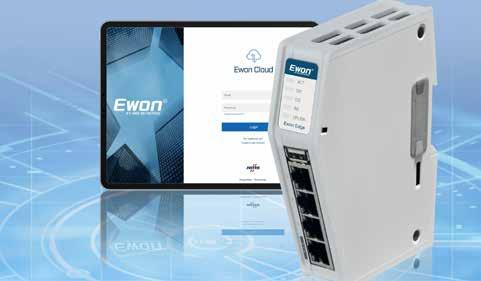
“With Ewon Cloud and Ewon Edge, we’re fulfilling our motto: ‘Hardware Meets Software,’” says Sébastien Thinnes, Vice President Marketing of HMS Networks’ IDS Division. “Machine builders and operators managing large fleets need a solution that’s powerful, secure, flexible, and evolutive. With over 500,000 Ewon gateways connected
PROFINET over SPE
worldwide, we understand industrial expectations. This knowledge shaped our new solution and reinforces our commitment to advancing industrial connectivity.”
HMS Networks
High-performance Edge-AI GPU computer for demanding AI applications in extreme environments.
PROFIBUS & Profinet International (PI) and its technologies are synonymous with a multitude of innovations and crossmanufacturer interoperability. When it comes to connectivity, this starts with connectors and cables.
This is currently already possible with two- and four-pair Ethernet cabling. And now Single Pair Ethernet (SPE), a connector for industrial automation, is continuing the success story. This brings clarity and certainty to a long-awaited topic. It is an important milestone that takes miniaturization a significant step forward with the help of SPE. With its forward-thinking structure, the new SPE connector system was realized based on essential application requirements. The SPE connector system is now being submitted for international standardization. The uniform pin connector pattern for applications in the control cabinet, in the field, and also for hybrid installations, creates “the” connecting element. This will pave the way for a universal SPE standard. For industry, this new generation is a further step forward into the future. Numerous manufacturers have

announced their intention to implement it in the near future.
Standardization work is also underway at other levels of SPE communication, such as a power concept. This will allow a consistent SPE solution to be achieved across all layers. Through the use of international standards, this solution can be used for all Single Pair
Ethernet applications, even at higher speeds. The world is becoming a clearer place thanks to PI, its dedicated members, and the many global supporters of Profinet.
Phoenix Contact
Learn More
IP video surveillance
Moxa adds new mobile camera to its VPort video surveillance solutions.
Moxa is extending the advantages of IP video surveillance to challenging transit applications with the debut of its new VPort 07-3, an EN 50155 compliant onboard dome camera. Hardened against service interruptions caused by heavy vibration, impact or water ingress, the new camera is a surveillance solution for light rail, buses, and passenger rail fleets. Built around a 3MP progressive-scan CMOS sensor, it captures sharp 2048 x 1536 pixel images at up to 20 frames-per-second, leveraging bandwidth efficient H.265/H.264 and MJPEG compression to support multiple independent streams, while benefitting from Moxa's DynaStream and CBR Pro network technologies.
As trains enter and exit passenger stations, underpasses, and tunnels, lighting can abruptly fluctuate from dark to light. Adding to these challenges, most rolling stock is in continuous operation both day and night. Regardless of lighting conditions, the VPort 07-3 assures forensic-quality imaging by adopting a powerful combination of Dynamic Noise Reduction (DNR), Wide Dynamic Range (WDR), and an advanced Auto White Balance (AWB) algorithm that resolves lighting challenges and reduces motion blur. Thanks to its 100dB WDR, the VPort 07-3
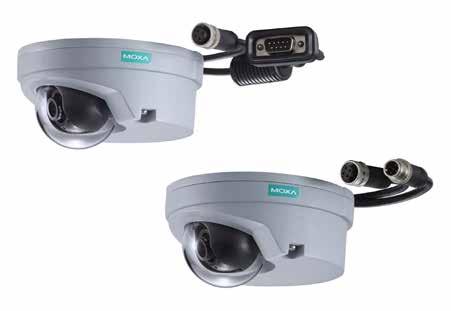
easily manages scenarios where there are significant variations in light intensity within the same frame, ensuring the smallest of details are visible in both bright and dark areas.
VPort 07-3 cameras are compliant with mandatory sections of the EN 50155 Railway
Safety local IO modules
MELSEC iQ-R modules enhance efficiency and reduce cost for safety in industrial automation.
Mitsubishi Electric Europe announced the launch of the MELSEC iQ-R safety local IO modules, featuring the RX40NC6S-TS and RY48PT20S-TS. These components are designed to enhance the lineup, increase efficiency and reduce safety costs in industrial automation.
The MELSEC iQ-R safety local IO modules offer significant advantages in industries where precision and safety are paramount. By eliminating the need for additional safety relays, the safety output module (RY48PT20S-TS) supports a maximum load of 2A per point, totalling 16A, ensuring cost savings and optimising cabinet space. This expansion of the safety lineup allows businesses to control machines and processes without compromising safety.
The compact design of the safety local IO modules allows for seamless integration next to your iQ-R safety modules. With 16 single input points on the RX40NC6S-TS and 8 single output points on the RY48PT20S-TS, these modules offer flexibility and high-speed safety digital IO, catering to the diverse needs of industries such as automotive, food

and beverage, life sciences, and machine builder. It's crucial for keeping workers safe and ensuring the factory runs without accidents.
Direct connection to the MELSEC iQ-R bus ensures faster reaction times, enhancing operational efficiency compared to safety over ethernet solutions. This advancement not
only boosts productivity but also underscores Mitsubishi Electric’s commitment to delivering innovative, reliable solutions for industrial automation.
Mitsubishi
Learn More
Certification and the EN 62262 IK8 vandalresistant rating.
Moxa
Visit Website
Combined PLC+HMI
A conveniently-sized and industrially-tough 4.3” multi-touch display, along with an integrated controller and expandable I/O, makes the FT1J Series ideal for visualizing and automating equipment and machinery.
IDEC Corporation has updated its SmartAXIS touch family with the new FT1J Series combined PLC+HMI. This device combines a built-in full function controller, both onboard and expandable I/O, and an advanced technology 4.3” touchscreen display, in a compact all-in-one form factor that is rightsized for visualizing and automating a wide range of applications. The FT1J Series builds on the success of the FT1A-C and -M Series 3.8” PLC+HMIs, and provides designers with another size option.
Combined PLC+HMI advantages
An all-in-one PLC+HMI requires far less panel door and interior space than individual devices. The unit’s thin bezel provides the greatest possible display area compared with its installation footprint, and the entire package requires only a shallow mounting depth clearance. Installation is simplified because the PLC and HMI are internally connected, share the same network connection, require only one power supply (and consumes less power than individually separate PLC and HMI installations), and all connections use push-in wiring connectors. Furthermore, the FT1J is ready to use and communicate right out of the box. End users configure the PLC+HMI with an intuitive and easily-used integrated development environment for both PLC and HMI functions, providing configuration and programming efficiencies.
Powerful PLC features
The integrated PLC and HMI each have a dedicated CPU and user memory for optimized scan time performance, and they communicate natively with each other. Built-in I/O includes 8 points of DC inputs (configurable as all discrete, or 6 discrete and 2 analog 0-10VDC or 4-20mA 12-bit). Discrete inputs can operate as high-speed counters up to 20KHz, with a maximum of 4 points of single-phase and 1 point of two-phase. For discrete outputs, a relay version provides 4 points of 2A relay outputs, while a transistor version provides 4 points of 0.5A transistor outputs. The transistor version also provides 2 points of 0-10VDC or 4-20mA analog outputs. Built-in transistor outputs are also pulse capable up to 200KHz.
The FT1J supports up to two expansion cartridges of discrete or analog I/O, in a variety of configurations and including a 2-point RTD/thermocouple analog input version. All analog inputs and outputs are 12-bit resolution. Also, designers can use the
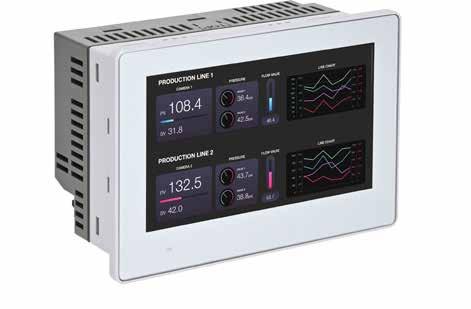
The FT1J combines a built-in full function controller, both onboard and expandable I/O, and an advanced technology 4.3” touchscreen display signals into PLC environments.
Ethernet port and the SX8R Bus Coupler to provide expanded amounts of remote I/O.
Cutting edge HMI design
The HMI’s projected capacitive touch panel (PCAP) advanced technology—like what is used for smartphones and tablets—saves space and improves performance, while providing 480x272 resolution and 16 million colors. Besides being water- and scratch-resistant, PCAP is very responsive, and it resists false signals when dirt or water droplets are present on the HMI face. Fewer touchscreen layers and better light transmission ratings mean less backlight power is needed, and the display provides an industry-leading 500 cd/ m² brightness level and 50,000-hour backlight life. In addition to being multi-touch, users can interact with the touchscreen HMI while using thin gloves. The front bezel carries no branding, of interest to many OEMs.
Robust performance
The glass-top design is wear-resistant even in harsh environments, and it delivers a long life with a 50,000-hour-rated backlight, making these units low maintenance. The battery-free design eliminates the need for replacements, reducing maintenance and easing overseas shipments by avoiding battery-related regulations. A hyper-capacitor maintains clock time for 20 days, while magnetoresistive random-access memory (MRAM) provides non-volatile storage for programs, retentive registers, and log data. Ratings for extreme
temperatures from -20 to 55˚C, IP66 and IP67 for wash-down areas, IP66F and IP67F for oil resistance, UL60101, UL Type 4X/12/13, and Class I Div 2 make the FT1J PLC+HMI suitable for a wide range of applications and locations.
Streamlined configuration
All PLC and HMI configuration is accessed through IDEC’s standard WindOI-NV4 software, which is easy-to-use and intuitive, with a drag-and-drop interface and extensive image library. Projects can automatically be converted from one HMI size to another within seconds. Script programming, PIDD loop control, pulse width modulation (PWM) control, multilingual capabilities, security, trend charts, data logs, alarm logs, and other functions and features are supported for both the HMI and the PLC. Users only need to keep track of one program file as it supports both the PLC and HMI.
Connectivity and IIoT
Two USB-A ports support flash drives for data logging, recipes, and program transfer— along with dongles for speakers, Wi-Fi, and Bluetooth. The embedded Ethernet port provides users with easy access for remote maintenance and communication, and the Modbus TCP/IP, BACnet IP, EtherNet/IP, and MQTT protocols are supported for connecting with other intelligent devices.
IDEC Corporation
Learn More
SOURCE:
FactoryTalk Analytics VisionAI
Solution is designed to help manufacturers improve product quality, maximize yield and gain critical insights from real-time production data.
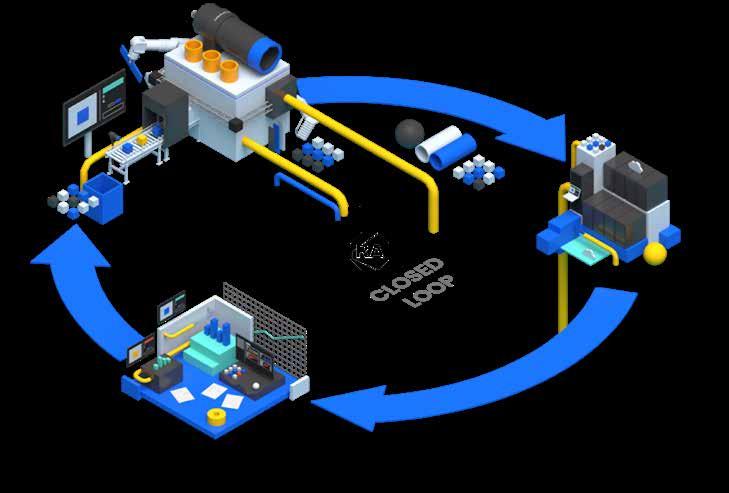
Solution empowers manufacturers to detect even the most subtle anomalies in product quality, enabling them to take corrective action quickly.
Rockwell Automation has introduced FactoryTalk Analytics VisionAI, a cuttingedge inspection solution that leverages artificial intelligence (AI) and machine learning to revolutionize quality control in manufacturing.
FactoryTalk Analytics VisionAI is designed to help manufacturers improve product quality, maximize yield and gain critical insights from real-time production data. This no-code solution allows quality personnel and plant operators to easily train AI models and deploy them across production lines without needing specialized machine vision expertise.
“FactoryTalk Analytics VisionAI empowers manufacturers to detect even the most subtle anomalies in product quality, enabling them to take corrective action quickly,” said Arvind Rao, vice president, industry solutions at Rockwell Automation. “It offers manufacturers a robust solution to not only detect anomalies with unparalleled accuracy and time to value but also to optimize
decision-making through AI-driven insights, ultimately improving operational efficiency”.
Key features of FactoryTalk Analytics VisionAI include:
• Advanced Anomaly Detection: Finds and classifies previously undetectable defects, delivering actionable insights
• Remote visibility, configuration and management: Manufacturers gain remote, centralized configuration and management of all inspection systems and visibility into their quality data from any location to understand performance trends across production lines
• Out of the box analytics: Built-in quality data analysis via pre-built dashboards, automated reporting, and quality event notifications that drives root cause analysis and continuous operational improvement
• Seamless automation integration: Premier integration with Rockwell control
systems for closed-loop quality control
• Scalable Hardware: VisionAI supports real-time inspections at production speeds using off-the-shelf components and integrates with standard Rockwell Automation hardware like ASEM™ IPC and Logix PLCs. This technology is supported by partnership efforts between Elementary, a Rockwell investment and vision AI company, and Rockwell. FactoryTalk Analytics VisionAI is built on secure, SOC 2 compliant cloud technology, ensuring enterprise-level manageability and cybersecurity. It integrates effortlessly with Rockwell’s FactoryTalk Hub and other automation systems, offering manufacturers a streamlined, scalable solution that enhances quality and productivity.
Rockwell Automation Visit Website
